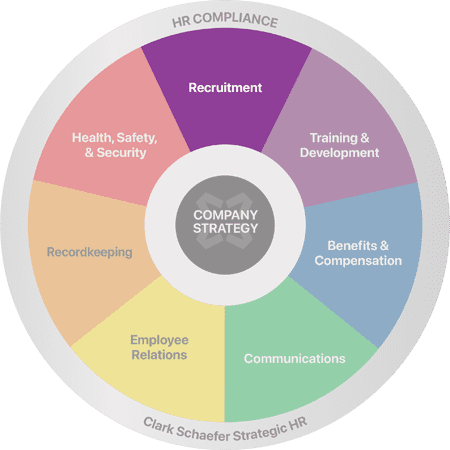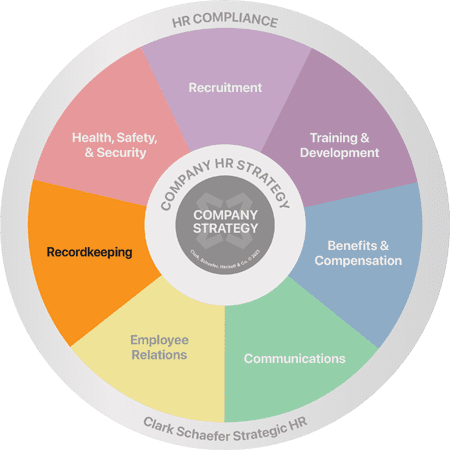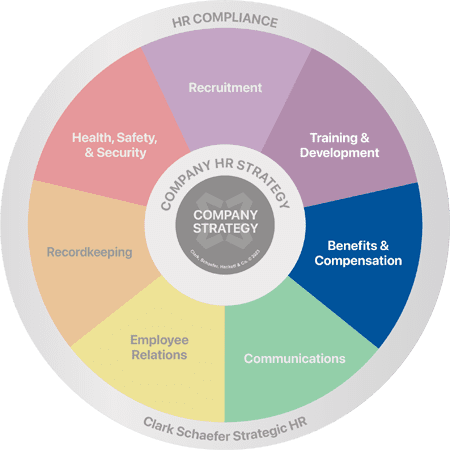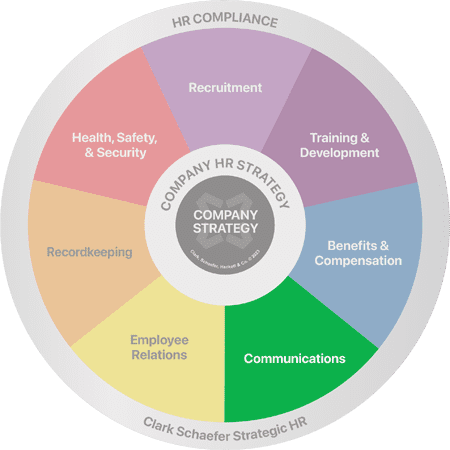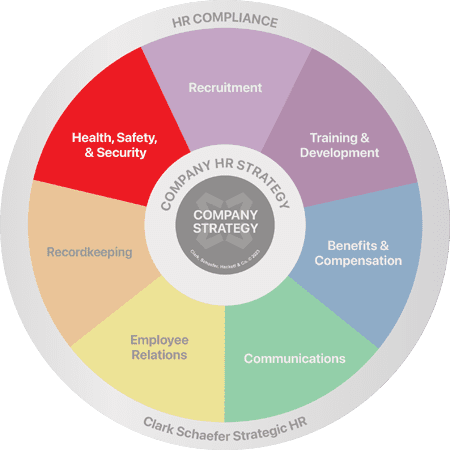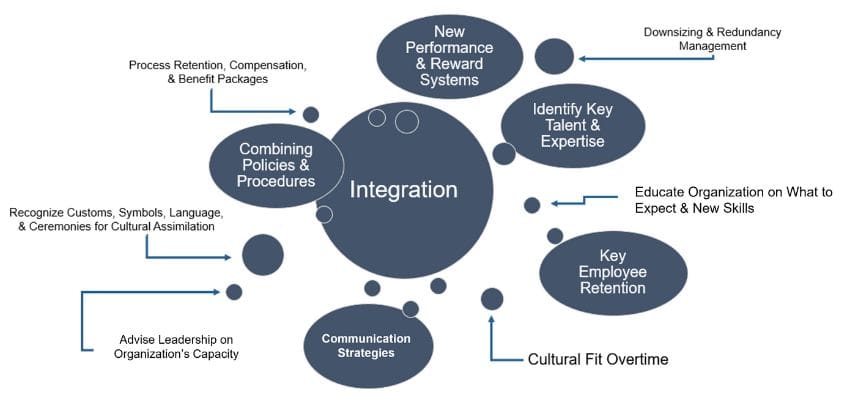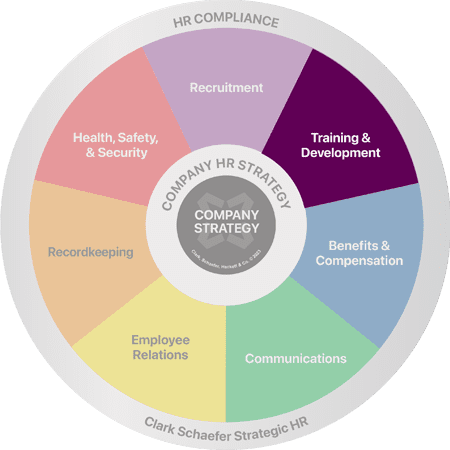Posts
HR’s Role During An Economic Crisis
Publishedin HR Strategy

High inflation, rising interest rates, record-low unemployment, and strong consumer spending seem to have economists scratching their heads. In today’s economic uncertainty, HR professionals are preparing to pivot to meet the needs of their organizations should the economy go into recession.
HR professionals are no strangers to navigating and leading through turbulent times. Throughout the pandemic, HR was and still remains on the front lines – leading change and creating a culture and space that supported a massive transition to remote work and pandemic-safe work environments. HR professionals demonstrated skills that had not been relied upon by many companies in the past, creating a focus on minimizing costs while engaging staff during challenging times.
HR professionals found themselves providing staffing insights to navigate difficult business decisions, offering creative problem-solving, and managing talent and culture, more than they ever have in the past. In this article, we will highlight several ways in which human resources professionals can continue to pivot and develop creative approaches to help their organizations weather the storm of the current economic crisis.
Assessing and Addressing Talent Needs
It may be expected that HR’s role during an economic crisis would center around talent. As companies make critical staffing decisions, the evaluation of talent and the use of that talent becomes paramount. During cost-saving conversations, significant efforts must be made to make effective use of staff. HR leaders can address these priorities through performance evaluations, development tools, succession plans, and cross-training initiatives.
Despite predictions, unemployment remains at historic lows and the Great Resignation could be seen as the beginning of a long-term shift in the labor market. For many businesses, growth has been slowed because of workforce shortages. Fortune indicates that the U.S. workforce participation rate has fallen to 62.3%, which is down from 67% in the late 1990s. More than ever before, HR professionals need to focus on strategies to help their organizations attract, retain, and develop high performers.
As organizations strive to meet their attraction and retention goals, they are also faced with the realities of the current economic conditions. The soaring cost of living has placed pressure on employers to increase salaries as paychecks are stretched by the significant increase in the prices of household goods. HR’s role is to help the business remain competitive in the job market by developing total compensation programs designed to motivate and reward high performance.
In addition to ensuring compensation and benefits are competitive, employers are challenged with meeting the needs and expectations of a multi-generational workforce. In our experience, the top reasons that job seekers across all generations choose to join a company besides salary are the ability to enjoy work-life balance and having growth and learning opportunities. HR can champion programs that motivate all generations of employees by offering ample paid time off, flexibility, and learning and professional development opportunities.
By taking a multifaceted approach, today’s HR leaders have the opportunity to create the workplace of the future that is designed with successful talent attraction and retention strategies built in.
Reskilling for the Future
As technology rapidly advances, one thing is certain – many businesses are finding a skills gap with current employees, and this gap is hindering growth. During times of an economic slowdown, HR can shift the focus to the future and find ways to fill skill gaps with current employees through training and development opportunities.
This can be a win-win situation as it helps the business to better meet its needs, and it addresses the desire of employees who are looking for growth and learning opportunities.
Managing the Mood
Difficult times become the most integral time to “manage the mood” of the company. Another component of HR’s role during an economic crisis is to partner with the leadership team to encourage and embrace a culture open to flexibility, evolution, and giving grace to others.
Particularly during times of economic downturns or layoffs, it can be hard to maintain the psychological safety of the team. This is the time to remain transparent in communications on what is happening in the organization, as well as recognizing what is left unknown. Employees left in the dark can become disengaged, putting your organization at risk of fostering a culture of quiet quitters.
Supporting Mental Health and Well-Being
Economic challenges always take a toll on employees in one way or another, and consideration must be made for the mental health and well-being of those that are at the heart of your organization to assure a thriving and productive environment. Promote your Employee Assistance Plans (EAPs), take advantage of the co-pay waiver of many health plans for mental health, and provide regular communication to staff on financial offers from local banks and community resources.
It’s no secret – HR’s role in this economic crisis has shifted and grown. The current economic crisis has put pressure on HR professionals and business leaders to do more with less. Businesses across the board are all looking for creative ways to engage their workforce, reinforce productive and positive behavior, and retain staff – all while allaying employee concerns and fears.
Human Resource professionals can and should take this unique opportunity to play a significant role in leading their organization through this national crisis. By showing their support of the business and its employees through appropriate economic-driven actions, they can support both the organization’s vision/mission and its employees’ health and wellbeing.
Special thanks to Colleen Mahoney, PHR, HR Business Advisor, for contributing to this article.
HR plays an integral role in optimizing your operations during challenging times. Clark Schaefer Strategic HR can help with your leadership and HR strategy. For more information, please visit our HR Strategy page, or simply contact us – we’d love to hear from you.
What Do I Have to Know Before Filing My EEO-1 Report?
Last Updatedin Recordkeeping

HR Question:
What is an EEO-1 Report and how do I know if I am required to file one?
HR Answer:
As defined by the Equal Employment Opportunity Commission (EEOC), the EEO-1 Report is an annual mandatory data collection of demographic workforce data, such as race/ethnicity, gender, and job categories. The window for the 2022 data collection will open in mid-July 2023.
Am I Supposed to File an EEO-1 Report?
Great question to start with! Not every employer is required to file an EEO-1 report. That being said, there are a few questions to ask yourself to understand if you need to file:
- Do you have 100 or more employees?
- Are you a federal contractor?
- Are you a first-tier subcontractor with 50 or more employees and at least $50,000 in contracts?
If you answered “yes” to any of the above questions, then you need to file an EEO-1 report annually. Employers also must file if the organization is any of the following:
- Owned by or affiliated with another company and the entire enterprise has 100 or more employees.
- Serving as a depository of government funds for any amount.
- A financial institution that is an issuing and paying agent for US Savings Bonds and Notes.
There are some organizations that are exempt, such as State and local governments, public primary and secondary school systems, institutions of higher education, American Indian or Alaska Native tribes, and tax-exempt private membership clubs other than labor organizations.
What Should I Know Before I File?
It always pays to be prepared! Before you start gathering the data yourself, here are a few tips to help you be better prepared to file your EEO-1 Report.
First, research and understand the requirements for filing. While these requirements don’t change frequently, it’s best practice to double-check the most up-to-date requirements, which can be found on the EEOC‘s website. If you have additional questions, the Message Center provides an outlet to reach out to the EEOC for guidance. This page will open in mid-July as the window for 2022 data collection opens.
Gathering the data yourself can be difficult. While this may not be an immediate solution, investing in an HRIS or a payroll system can be a great resource. Some software includes an HR solution that provides an efficient and accurate way to access the employee data needed to complete the report accurately.
If you do not have an HRIS or payroll software solution, you can have each employee complete an EEO Self-Identification Form. This form is voluntary, however; if an employee declines to identify, the federal government requires you to determine this information by visual survey and/or other available information.
How Do I File?
If your company has never filed an EEO-1 Report before, let’s start with the basics – creating an online account. Visit the EEOC Data page, select “Create an Account,” then log in to the EEO-1 Component 1. At that point, new users can link their individual user account to a company record by selecting “Add Company to List” on the Your Company List page and entering your company’s EIN. After you register, you will receive your Company ID and PIN.
You will need the following information to complete the report:
- Company ID and PIN
- Company EIN and NAICS code
- Company DUNS Number (if the company is a federal contractor)
- Establishment address(es) – for a single-establishment, submit only one EEO-1 data report; for a multi-establishment company, submit a separate report for each location.
- A count of all full-time and part-time employees during the specified pay period you have selected (for 2022 reporting in 2023, you can select October, November, or December of 2022)
- Gender and race/ethnicity of all employees
- Job categories for all employees
- Employment data from one pay period in October, November, or December of 2022
Once the report is finished, it needs to be certified and submitted. Don’t forget to click the “certify report” button; otherwise, the EEOC will not receive your report.
Thank you to Sherri Hume, SHRM-CP, HR Business Advisor, for contributing to this edition of our HR Question of the Week.
Recordkeeping is one of the more mundane tasks associated with Human Resources, but it is extremely important and can get you into hot water (i.e., incurring fines) if not done properly. Keeping the right files easily accessible and up-to-date is vital. Need some help? Visit our HR Compliance & Recordkeeping page to learn more.
Designing a Modern Dress Code for Today’s Workplace
Last Updatedin Communications

HR Question:
We’re taking a look at revising our dress code policy. We want to balance today’s increasingly casual approach while still asking our team members to look professional. How can we create a modern dress code policy?
HR Answer:
In today’s modern workplace, the concept of dress code has evolved to reflect a more relaxed and individualistic approach. Many companies have moved away from the traditional suit, skirt, button-down, formal shoes, tie, etc. combinations that were common in the past. One of the main reasons for this shift is the changing nature of work itself.
Many jobs today are more creative and require a more individualistic approach. This means that employees are encouraged to express themselves through their clothing choices, as long as it is appropriate for the workplace. Additionally, as younger generations gain a larger presence in today’s workforce, employers have recognized the need to allow for personal expression through clothing and accessories with a lean toward a more casual dress code to attract and retain top talent.
Designing a dress code for the modern workforce is an important task and requires a delicate balance between creating a professional and inclusive environment. Here are some steps to consider when designing a dress code:
Identify your Dress Code Requirements
First, identify the requirements of your workplace, including the nature of the work, the industry, workplace safety, and the expectations of the customers or clients. It might help to categorize your approach in typical dress code categories that most individuals are familiar with, such as business casual, casual, smart casual, company attire/uniform, and business attire.
For those unfamiliar with those guidelines, providing examples is your best route to clearly outline expectations. For example, you could provide images or descriptions of appropriate attire and accessories. These examples will guide the type of attire that is appropriate for your workplace.
If the nature of an employee’s work and who they interact with varies daily (i.e., Are they customer-facing all of the time? Some of the time? Not at all?), that may result in the expectations for their level of dress to change from day to day depending on these factors. So if your dress expectations do vary, we recommend that you clarify this in your dress code policy to help employees navigate through this appropriately.
Make Sure It’s Inclusive
It’s important to balance the need for professionalism with the desire (or need, in some cases) for individual expression, respect for other cultures, and/or the way individuals identify. For example, establishing expectations or limits around how someone wears their hair could limit someone’s ability to abide by their religious beliefs or could discriminate against hairstyles that have cultural significance. For example, The C.R.O.W.N. Act was created for this very reason.
Developing an inclusive dress code should also factor in gender identity. Avoid gender-specific language and instead use gender-neutral language, such as “employees should wear professional attire, such as a suit and tie or skirt and blazer” instead of “men should wear a suit and tie.”
Be Flexible & Seek Feedback
Flexibility is key when designing a dress code that is inclusive of all genders. Consider allowing employees to choose from a range of acceptable attire options, rather than prescribing a specific dress code. If your organization maintains a uniform (ideally, one that can be considered gender-neutral), consider allowing employees to express themselves through accessories or subtle variations in attire, while still maintaining an appropriate level of professionalism.
Finally, seek feedback from employees to ensure that the dress code is meeting their needs and is inclusive of all genders. Encourage open communication and consider making adjustments as needed.
Overall, designing a dress code for the modern workforce requires a thoughtful and inclusive approach that balances professionalism and individual expression. While there are still certain expectations and guidelines that should be followed, employees are encouraged to express themselves through their clothing choices. By understanding your workplace culture and asking employees to dress appropriately for their positions, you can help them find and maintain a healthy balance between professionalism and self-expression.
Thanks to Cassie Whitehouse, M.Ed., for contributing to this edition of the HR Question of the Week!
Trying to find ways to create inclusive policies? Want to build a welcoming environment, but not sure how to develop policies and procedures that reflect that? Our team at Strategic HR can help you create policies and procedures that clearly lay out your expectations of your employees while creating a flexible and inclusive environment. Contact us today or learn more about how Strategic HR can help you remain compliant, avoid unnecessary obstacles, and increase employee trust, engagement, and satisfaction through HR Communications.
What Questions Should I Ask During An Exit Interview?
Last Updatedin Employee Relations

HR Question:
We’ve decided to start conducting exit interviews but aren’t sure of the right questions to ask. What are some key questions to ask during an exit interview?
HR Answer:
Exit interviews are an important part of the employee life cycle. These interviews, conducted after an employee has formally turned in their resignation and is in their last few days of employment with your organization, allow you to get feedback to examine and potentially improve processes, expectations, and experiences within the company. While typically conducted with an employee who is leaving on their own terms for another opportunity, you can also conduct exit interviews with those employees who are relocating, retiring, or leaving for personal reasons.
Take the time to discuss topics such as pay and benefits, team culture and expectations, and reasons why someone may have felt prompted to search for opportunities elsewhere. The answers to these questions can help you develop strategies for your HR processes. Plus, this feedback is critical to reducing turnover and creating an environment your employees want to work for. You can’t fix what you don’t know, and you won’t know unless you ask. Preparing ahead of time can allow you to ask focused questions that will lead to the necessary answers.
How to prepare for an Exit Interview
The first step in conducting an effective exit interview is to ask yourself what you are hoping to accomplish by talking to the exiting employee. Are there areas or blind spots that they may be able to shed light on or provide additional insight into? This opportunity will allow you to gather feedback that current and remaining employees may be too hesitant to share.
You may have some suspicions as to the underlying reason(s) for employees’ departures, so this can be an opportunity to test out your hypotheses. For example, you may be concerned that your salary ranges are not up to date with your market and industry, and you are lagging behind your competitors. Or is the employee leaving because of a manager, supervisor, or co-worker? Do you want to look at your culture to see if it promotes teamwork, accountability, and appreciation?
Additionally, be prepared to see the organization through this individual’s lens. They may not have had the best experience, or perhaps they felt consistently frustrated by certain elements. As a result, be prepared to listen to their feedback (and potential negative approach) with an impartial ear and an eye looking for potential opportunities for improvement.
What questions should I ask?
After determining the why, start creating questions that will get you the information you are seeking. Of course, there are many questions that you could ask, so we recommend you identify a set of questions that can be discussed in a reasonable amount of time. Here are some suggestions:
- Were you looking for a job (and if so, what made you decide to start looking)?
Because of the current job market, many employers pursue passive job seekers and provide the employee with a terrific employment opportunity. If the individual was actively applying for new roles, this might help get to the root of why they wanted to leave. - What caused you to accept the position?
This is where the interviewer can get to a key differentiator between their organization and their competition. More pay, better benefits, remote work, work culture, toxic manager, etc. may be reasons why the offer made couldn’t be refused. - Did your manager meet your expectations for providing appropriate direction, support, and leadership?
It is often said that people leave a manager, not a job. If their expectations weren’t met, ask probing questions to understand why. This can shed light on any supervision and leadership issues that may need to be addressed. - How can our company improve our training and/or onboarding process?
For those newer to your company, this question allows you to determine how the employee felt about their first few months in your organization and if they feel they received sufficient training to do their job. If the employee has been with your organization for a longer time period, be sure to clarify that their suggestions can also come from their experience or role in training and onboarding processes as well. - What, if anything, would you have changed about your job?
A good follow-up question to this one is “if that change were implemented, would you return to work here?” Again, this question can get to the root cause of the turnover, and if the departing employee feels strongly enough about the company to consider returning at a future time. Remember that boomerang employees can be an asset to your organization as they can return re-energized and more engaged, so keep that door open when it’s appropriate to do so. - Would you refer a friend or family member to work here?
This question can give you additional information about the culture of the organization. If the answer is “yes, but not in my department,” follow-up questions may again reveal issues that should be addressed.
For additional areas to probe, Glassdoor provides more exit interview questions to consider.
What to do after an Exit Interview
After the exit interview, consider how you will use the data. Are you sharing it with the managers or leadership team, or are you checking the exit interview off your list and storing the information? Look for themes, especially if there is increasing turnover in one department or position. For example, are all of your customer service representatives leaving because they didn’t feel as though they were trained appropriately? Do your departing IT professionals complain about a lack of support from their manager? Use the data from exit interviews to create action plans to address issues and concerns.
Exit interviews can be used as a great tool to target turnover and retention issues. An effective exit interview is also valuable in pinpointing management and cultural challenges in an organization if the data is used appropriately. An alternate strategy is to open lines of communication with employees before they leave by conducting employee surveys or implementing stay interviews to identify and address issues before they choose to exit.
Thank you to Sheryl Fleming, MA, SHRM-SCP, for contributing to this HR Question of the Week.
Do you know why your employees choose to leave your organization? Exit interviews, while time-consuming, can be key tools for better understanding your company’s retention opportunities. Our team at Strategic HR can help you construct and conduct stay and exit interviews to learn more about why employees stay or go. Visit our Employee Relations page or Contact Us to learn how we can lend a hand in your employee retention efforts.
What is Equal Pay Day?
Last Updatedin Benefits & Compensation

HR Question:
I keep seeing information about “Equal Pay Day” during Women’s History Month. What is Equal Pay Day, and how can I recognize it in my organization?
HR Answer:
Equal Pay Day is a symbolic day that puts into perspective the 23% pay gap between a woman and a man in the same role. Based on the current gap, a woman has to work one full year plus several additional weeks into the following year to make the same amount that her male counterpart made in one year alone.
In 2023, Equal Pay Day is March 14, representing the 2022 US Census Data showing women make 84 cents (all full-time workers) and 77 cents (all full-time, part-time, and seasonal earners) for every dollar paid to non-Hispanic, white men. This translates to an annual wage gap of $9,954. That gap is unfortunately even larger for most women of color, resulting in a gap of $.64 on the dollar for Black women, $.62 for mothers, $.61 for Native Hawaiian and Pacific Islanders, $.54 for Latina women, and $.51 for Native and Indigenous women.
Equal Pay Day was established in 1996 by the National Committee on Pay Equality (NCPE). The day is recognized annually, but not always on the same date due to the pay gap calculation. Even though Equal Pay Day has been around for 27 years, it is more widely recognized today, in part due to the stronger focus on eliminating the gap. Current initiatives, such as pay transparency and salary history ban laws, were introduced by individual cities and state-wide to address the pay gap.
Where are Equal Pay Laws in Place?
On January 1, 2023, three new states were added to the list of city and state governments that passed laws to protect applicants by banning employers from asking about prior salary history and/or requiring that companies list salary ranges in their job advertisements. Currently, the following governments have such laws:
States:
- California
- Colorado
- Connecticut
- Maryland
- Nevada
- Rhode Island
- Washington
Cities:
- Cincinnati, OH
- Ithaca, NY
- Jersey City, NJ
- New York City, NY
- Toledo, OH
- Westchester County, NY
According to the Society for Human Resource Management (SHRM), pay transparency is one of the top issues people managers will face in 2023. According to Monster’s 2022 poll, 98% of workers believe salaries should be disclosed, with another 53% of applicants refusing to apply for a position if the salary is not disclosed.
How Can I Support the Movement?
So how can employers address the gender gap and honor Equal Pay Day in their organizations? Some recommended ways include:
- Performing an Equal Pay Audit to review job classifications, salaries, and genders and take corrective actions if inequity is found.
- Reviewing compensation policies to remove gender bias.
- Removing managerial discretion on pay and sticking to a salary band of positions for new hires and for annual increases.
- Removing prior salary history from applications and interviews.
- Establishing fair scheduling practices to allow for caregiving.
For even more ways to contribute to awareness and celebrate Equal Pay Day you can visit equalpaytoday.org.
Thank you to Paula Alexander, MA, PHR, SHRM-CP, for contributing to this HR Question of the Week!
Performing an equal pay audit can be a complex, but necessary, step toward equal pay for all. Clark Schaefer Strategic HR is ready to assist you with any of your needs around Benefits and Compensation. We offer assistance with everything from job descriptions to policy development to help address your complex issues that impact employee compensation or benefits. Please visit our Benefits and Compensation page for more information on how we can assist you.
How To Set Up An Employee Bonus Plan
Last Updatedin Benefits & Compensation
Could Sabbaticals Be Your Next Retention Tool?
Last Updatedin Benefits & Compensation, Employee Relations

HR Question:
In today’s fast-paced and high-pressure market, it’s difficult to truly disconnect from work. We’ve been trying to find ways to give our team a break to avoid burnout, but sometimes a week of vacation just isn’t enough. Could sabbaticals be the newest tool in our retention toolbox?
HR Answer:
You’re not alone in considering sabbaticals as they seem to be gaining in popularity. According to a recent World at Work survey assessing US organizations ranging in size and industry, 10% of organizations offered paid sabbaticals (up from 7% in 2019), and 29% offered unpaid sabbaticals (up from 16% in 2019). Now, as we’re well into a period with many different names – the Great Reshuffle, the Great Resignation, the Great Re-Evaluation to name a few – sabbaticals may be the unsung hero that benefits both employers and employees alike when it comes to talent retention, supporting good mental health, and strengthening employee engagement and dedication to their work and your organization.
Time to Re-Charge, Re-Energize, and Reconnect
It’s no secret that the first beneficiary of a sabbatical is the employee. Unfortunately, those who do choose to take sabbaticals may often lack the opportunity to properly enjoy them. In fact, The Sabbatical Project reports that nearly two-thirds of those who do take a sabbatical are often forced into them due to traumatic circumstances out of their control – the loss of a family member, health issues, the need to navigate complex or dissolving relationships, etc. Not exactly the most relaxing setting for a rejuvenating and relaxing period of time.
Although a sabbatical can be used to address such issues, it could benefit organizations to promote them for a broader purpose. Employees should be encouraged to consider using a sabbatical as an opportunity to truly disconnect, re-energize, and re-focus if suffering from burnout or fatigue. They can also be used to discover new passions, chase hobbies, and gain the experiences that many may put off until after retirement.
Sabbaticals Benefit the Employer Too
And while a sabbatical, paid or unpaid, can seem like an intimidating amount of time away from the desk for both the employee and the employer, the benefit of a re-energized and re-engaged employee can pay back dividends. Interviews for a Charter and TIME article revealed employees who returned from a sabbatical found themselves more creative, felt greater feelings of loyalty and energy, and brought new ideas to the table.
When considering the cost of having to replace a long-term employee, along with their organizational knowledge, skills, and work relationships built over time, offering a sabbatical as an opportunity to renew and recharge may be far more cost-effective. In addition, offering sabbaticals as part of your benefits package is not only attractive to retain current employees, but can also be a valuable talent acquisition tool to attract new talent.
Your Team Will Benefit From Your Time Away
The longer nature of sabbaticals creates an opportunity for cross-training. As opposed to managing through vacations where you can push a project or a question off “just a few days” until a person returns, sabbaticals present a fantastic opportunity to engage other team members in new and different tasks, departments, and levels of the organization – providing the employer with a built-in opportunity for the career development and growth that ranks high on job seekers’ lists today.
Sabbaticals Don’t Come Without a Cost
It would be a win-win if sabbaticals came without a cost to the employer or employee, but unfortunately, that’s not the case. That’s why it’s important that employers establish their promises and expectations for sabbaticals. How often and for how long can employees be away? Do they need to serve a certain number of years to qualify? How much of their regular pay will they still receive, if any? How does a sabbatical tie into their PTO or other time off categories?
While the cost may not be a surprise, the money saved by creating an attractive workplace, providing necessary mental health benefits, and showing that you’re an organization committed to putting employees’ needs first may very well pay dividends in attracting and retaining valuable talent.
Special thanks to Samantha Kelly for contributing to this HR Question of the Week!
Providing adequate Benefits and Compensation for your employees is key to the recruitment and retention of a well-performing workforce, and having the right policies in place can make or break a company. Clark Schaefer Strategic HR can help you structure your benefit and compensation system to meet today’s competitive market. Please visit our Benefits and Compensation page for more information today.
Succession Planning: How Can We Prepare for Exits of Key Employees?
Last Updatedin HR Strategy

HR Question:
I’ve been hearing more and more about the importance of succession planning should any of our key employees or leaders resign. How can our organization make sure we’re appropriately prepared for succession planning so we are well-positioned if we should lose any key players?
HR Answer:
The exit of a key employee can certainly result in turbulence within a business. Lack of preparation in filling such an important role can fuel skepticism about the future of the company among both internal employees and external stakeholders. Organizations can help temper such concerns and instability through succession planning.
Benefits of Succession Planning
Thoughtful succession planning leads to numerous benefits. Organizations that hire their leaders internally may benefit from a better quality of hire than those who look externally. According to a study at the University of Pennsylvania, although internal hires are typically paid less than external hires, they tend to perform better and have lower turnover rates. The success of internal hires may be in part attributed to a deep understanding of the business and culture, along with cultivated relationships amongst the organization, its partners, and customers.
Succession planning also serves to foster goodwill among current employees who see the organization’s faith and investment in its internal talent. Especially considering the challenges in today’s talent market, succession planning may help to increase employee loyalty and tenure within an organization.
To begin succession planning, it is important to consider the strategic direction of the organization. You may pose the questions: what roles will we need to support the future goals of our organization? What kind of growth is expected in the next 1-5 years? Determining the trajectory of the organization will better inform the roles on which to focus your succession planning efforts. Executive leadership and directors constitute critical roles that typically merit inclusion in the process. However, organizations should also include key individual contributors who possess highly specialized skills or knowledge in their succession planning efforts.
Conducting a workforce assessment
Once critical roles are identified, it is important to conduct a workforce assessment to consider factors that may affect the stability of these key roles, such as incumbent retirement eligibility. During this portion of the process, it is also essential to identify members of the internal talent pool who may be able to fill these critical roles, with the right development opportunities. You should consider the current performance of these employees, as well as their future potential. Finally, when evaluating your internal talent pool, you will want to ensure that your pipeline of emerging leaders is diverse and can bring distinct perspectives to these key roles.
Identify gaps in knowledge and skills
Next, you will want to identify any gaps between the knowledge and skills possessed by the incumbents of critical roles and those in the talent pipeline to succeed them. Once these gaps are determined, leaders can begin creating career development plans in partnership with high-potential employees. Such career development plans may include shadowing a key employee, engaging in a mentorship program, or participating in a stretch assignment for exposure to new business functions, geographies, and customers. A career development plan may also include courses or seminars to help hone essential technical or soft skills. Finally, as part of their development process, high-potential employees could be invited to participate in board meetings for additional exposure to strategic planning initiatives.
It is important to note that succession planning is not a one-time initiative, but rather constitutes an ongoing process by which the internal talent pipeline is continually identified and developed. Organizations that implement thoughtful and strategic succession planning will benefit not only from increased stability during the exit of a key employee, but also from enhanced loyalty of employees who see the organization’s investment in its internal talent.
Thank you to Christine McLaughlin, HR Business Advisor, for contributing to this HR Question of the Week.
Whatever HR challenge your business may be facing, Clark Schaefer Strategic HR can help! Whether it’s by developing a robust internal succession planning process, creating or improving your performance management system, or developing a comprehensive strategic business plan through our HR Strategy services, our team of experienced consultants is waiting to partner with you. Contact us to talk through your HR Strategy needs.
Are You Ready For These Top HR Trends in 2024?
Last Updatedin HR Strategy

As we transition into a new year, the world of Human Resources is poised to undergo several transformative trends that reflect the evolving landscape of work. Some transformations are already at work, such as the continued integration of technology in HR processes, with the adoption of artificial intelligence (AI), data analytics, and automation tools. These technologies are not only streamlining administrative tasks but also enhancing decision-making processes, enabling HR professionals to focus on more strategic and value-added activities.
Additionally, an emphasis on employee well-being is gaining momentum, with organizations recognizing the importance of creating a positive work environment that promotes mental health, work-life balance, and overall job satisfaction. Our team anticipates that remote and hybrid work arrangements will persist, prompting HR departments to refine policies and practices to accommodate diverse and flexible work setups that continue to support a diverse workforce with varying needs.
And finally, we expect diversity, equity, inclusion, and belonging initiatives will also remain at the forefront of the HR landscape, as companies strive to create more inclusive and equitable workplaces. DE&I efforts go hand in hand with employee well-being and employee satisfaction. As employers work to foster diverse and inclusive workplaces, they are also challenged to be highly transparent in their communications and actions and to build a high level of trust, which leads to employee satisfaction and retention.
So how do we expect to see these HR trends play out in the coming year?
Generative AI & Upskilling
In a June 2023 survey by Gartner, 81% of HR leaders have already begun to explore and implement AI solutions within their organizations, with 52% exploring potential use cases and opportunities for generative AI. Indeed, the Future of Jobs Report 2023 indicates that by 2027, 43% of work tasks will be automated.
The Future of Jobs Report also emphasizes the growing focus on cognitive skills within the workforce – skills like creative and analytical thinking, technology, literacy, and socio-emotional attributes such as curiosity, resilience, and lifelong learning.
Upskilling in the field of human resources is expected to become increasingly important in the coming years and will play out in a variety of ways:
1. Technology Integration
The HR field is becoming more technology-driven with the adoption of complex HRIS (Human Resource Information Systems), AI-driven tools, and data analytics. HR professionals will need to quickly upskill to effectively utilize these technologies and leverage artificial intelligence for HR tasks such as recruitment, employee engagement, and talent management and development.
As HR professionals explore ways to weave AI into their daily operations, it’s also important to understand the ethical and legal concerns of AI adoption.
2. Data-Driven Decision-Making
HR professionals are increasingly relying on data to make informed decisions in areas such as workforce analytics, recruiting, employee performance, and strategic planning – even more so with the rise of AI. Consider providing data analytics training opportunities to help employees successfully engage and understand the results these technologies can provide.
3. Soft Skills and Emotional Intelligence
With the rise of remote work and digital collaboration, the importance of soft skills and emotional intelligence will continue to be sought after. HR professionals need to be adept at interpersonal communication, empathy, and understanding diverse perspectives – especially when so much interpersonal context is lost from behind a screen. Upskilling in these areas will be vital for effective employee relations, conflict resolution, and fostering a positive workplace culture.
4. Continuous Learning Culture
HR professionals should model and promote a culture of continuous learning within organizations. Reevaluating learning and development strategies, assessing training methodologies, and implementing ideal learning technologies will be essential to support the professional as well as personal growth of employees.
In summary, learning to utilize AI in beneficial ways, as well as upskilling across organizations, will create a mix of technical, interpersonal, and leadership skills that help employees adapt to the evolving workplace landscape and allow HR leaders to contribute to the success of organizations in highly valued ways.
Employee Well-Being
Companies are increasingly recognizing the importance of employee well-being. The employee well-being umbrella includes mental health support, work-life balance and remote work initiatives, and wellness programs, in addition to providing meaningful work and opportunities for learning and development. The expectations of employers are growing by the minute!
The top 5 ways employers can support employee well-being in the upcoming year include a combination of physical, mental, and professional support:
1. Flexible Work Arrangements
Offer flexible work hours and remote work options to accommodate diverse employee needs. A flexible work environment allows employees to better balance their professional and personal lives, reducing stress and enhancing overall well-being. To learn more, check out Gallup’s article, “The Future of the Office Has Arrived: It’s Hybrid,” as well as Techopedia’s Remote Work Predictions for 2024.
2. Mental Health Programs and Resources
Prioritize mental health by providing access to counseling services, mental health workshops, and Employee Assistance Programs (EAPs). Promote a culture of openness and destigmatize mental health issues to encourage employees to seek help when needed.
3. Professional Development Opportunities
Invest in employees’ professional growth by offering training programs, workshops, and opportunities for skill development. Providing clear pathways for career advancement and continuous learning not only enhances employees’ job satisfaction but also contributes to their overall well-being.
4. Health and Wellness Initiatives
Implement comprehensive health and wellness programs that address physical well-being. This can include fitness classes, wellness challenges, health screenings, and initiatives that promote a healthy lifestyle. Consider providing wellness benefits such as gym memberships or wellness reimbursements.
5. Regular Check-ins and Feedback
Conduct regular one-on-one check-ins between managers and employees to discuss workloads, career goals, and any challenges they may be facing. Foster open communication and create a supportive environment where employees feel comfortable sharing their concerns.
Check-ins allow for the opportunity to course-correct, as needed, and to ensure that employees have the resources they need to do their jobs successfully. In addition, providing constructive feedback and recognition for accomplishments contribute to a positive work experience.
These strategies collectively address various aspects of employee well-being, creating a holistic approach that considers both personal and professional needs. Employers need to tailor these initiatives based on their workforce’s specific characteristics and preferences, promoting a culture that values and prioritizes the well-being of employees.
Diversity, Equity, Inclusion, and Belonging
Diversity, Equity, Inclusion, and Belonging (DEI&B) initiatives are more than passing HR trends, but rather, essential for creating a workplace that is welcoming, inclusive, and representative of all individuals. In 2024, employers can take several actions to support and enhance their DEI&B efforts:
1. Establish Clear DEI&B Goals and Metrics
Clearly define and communicate DEI&B goals that align with the organization’s values and mission. We recommend using a DEI&B roadmap as you build your diversity initiatives. Establish measurable metrics to track progress and hold the company accountable for achieving diversity, equity, and inclusion objectives. Regularly assess and report on these metrics to demonstrate transparency and commitment.
2. Cultivate an Inclusive Workplace Culture
Foster a culture of inclusivity where all employees feel valued, respected, and heard. Encourage open communication, apply inclusive decision-making principles, and create platforms for employees to share their experiences and perspectives. Implement training programs to raise awareness about unconscious bias, microaggressions, and other barriers to inclusivity.
3. Diverse Hiring Practices
Implement inclusive hiring practices to attract a diverse talent pool. This includes using diverse interview panels, removing bias from job descriptions, and actively seeking candidates from underrepresented groups. Consider partnerships with organizations focused on diversity recruitment and outreach to expand your talent network.
4. Professional Development and Mentorship Programs
Provide opportunities for professional development and mentorship, particularly for employees from underrepresented groups. Establish mentorship programs that connect employees with mentors who can guide and support their career growth. Ensure that these programs are accessible and inclusive.
5. Employee Resource Groups (ERGs)
Establish or enhance Employee Resource Groups that cater to specific communities within the organization. These groups provide a platform for employees to connect, share experiences, and contribute to the development of a more inclusive workplace. Support and actively engage with ERGs to ensure their success and impact.
6. Equitable Policies and Practices
Regularly review and update policies and practices to ensure they are equitable and unbiased. This includes performance evaluation processes, promotions, and compensation structures. Strive to eliminate systemic barriers that may disproportionately affect certain groups within the organization.
DEI&B initiatives require ongoing commitment and effort. Employers should listen to the needs and concerns of their employees, continuously educate themselves and their teams, and adapt their strategies based on feedback and evolving best practices. By taking a comprehensive and proactive approach, employers can contribute to building an inclusive workplace that reflects the diversity of the global workforce.
For ideas to enhance your DEI&B programs, the Society for Human Resource Management (SHRM) offers “4 Ways to Promote Authentic DE&I Practices.”
As we stand on the brink of a new year, the field of Human Resources is on the cusp of significant transformations, mirroring the dynamic nature of the modern workplace. Employers play a pivotal role in steering organizations toward a progressive and thriving future. Recognizing our employees as the cornerstone of success, we can aspire to cultivate environments that prioritize well-being, embrace diversity and inclusion, a new digital world, and adapt to the evolving needs of our workforce.
As we navigate these HR trends and challenges, let us collectively champion a workplace culture that not only reflects the spirit of the times but fosters growth, innovation, and lasting success for individuals and organizations alike.
Thank you to Collen Mahoney, PHR, and Cassie Whitehouse, M.Ed., for contributing to this HR Question of the Week!
Need help tackling your HR Strategy for 2024? Let our team of HR experts assist in building your plans for the new year. Please visit our HR Strategy page to learn more, or simply contact us – we’d love to hear from you.
Why Is It Important To Get An Employee’s Signature?
Last Updatedin HR Strategy, Recordkeeping

Have you ever had an employee question an employment agreement or say they didn’t mean to agree to a term of their employment? Why is it so important to get an employee’s signature?
This is a critical question for all employers, and the answer applies to more than just employment agreements! At its root, a signature is used to show the intent of an individual to bind oneself to a contract or make a written representation.
Why is an Employee’s Signature Important?
In the case of a new hire’s employment agreement, the signature here binds both the employee-to-be and the company to the agreed-upon terms such as salary, benefits, schedule, etc. – all items you don’t want to have to argue over after the employee has already started.
There are other instances where having an employee’s signature can help to protect your organization beyond the employment agreement. For example, when memorializing a performance conversation, it may be important to have an employee make a written representation of the fact that they were there, they understand the conversation, and they’ve agreed to any future action discussed during the meeting.
Obtaining an employee’s signature on documents such as these not only helps to clarify expectations, but it can also be an important part of your organization’s risk mitigation.
Employee Signature Best Practices
These signed documents are used should the agreement, the conversation, or actions be called into question, whether that’s internally or in a court of law. To eliminate additional confusion, there are best practices when gathering employee signatures.
A signature in ink is recognized as the standard for executing documents. However, should in-person not be an option (as many organizations have experienced a significant increase in remote workers), other legally recognized methods of signing are effective. These may include a scanned PDF of a signed document with an original signature or obtaining an electronic signature using software that is legally recognized, such as DocuSign, Adobe, certain payroll services, etc.
All in all, it goes back to showing intent to sign should anyone ever question that an agreement was created.
What Doesn’t Count as a Signature?
What you want to avoid is a question of fraud or whether an individual intended to enter into the agreement. Just typing a name using script font instead of using an original signature is typically not sufficient because it is easier to claim that it was created by someone other than the named party.
Additionally, simply cutting and pasting a picture of a person’s original signature into a document, as is sometimes done on letters, isn’t recommended because it can be more easily used to create counterfeited documents (or alleged to be counterfeit by a party not wanting to be bound by the agreement). Having said that, it is slightly better than typing in script font.
In the end, it is important to protect both parties – the employee and the company – with original or well-documented signatures in the case of disagreements or audits. By taking a little bit of additional time upfront to ensure that you’ve gathered an employee’s signature correctly, you can prevent a significant amount of wasted time and money later down the path.
Special thank you to Emily Smith, JD, General Counsel for Clark Schaefer Hackett, and Sammie Kelly for contributing to this Emerging Issues in HR.
Although maintaining proper recordkeeping practices may not be everyone’s forte, it is a critical piece to help protect both your organization and your employees. But don’t worry, Clark Schaefer Strategic HR are here to help! We can conduct an HR Audit to review your HR policies, procedures, documentation, and systems to identify any areas for improvement or enhancement in your HR function. To learn more, visit our HR Audit page or Request an HR Audit Quote.
How To Determine If A Home Office Injury Is Covered By Workers’ Compensation
Last Updatedin Health, Safety & Security

HR Question:
Our company has agreed to allow employees to work a hybrid schedule, allowing them to work from home on multiple days during the week. Although this has been very well received by employees, we have seen an increase in the number of injuries from employees working from home. How do I know if a home office injury is covered by workers’ compensation, and how do I handle these claims?
HR Answer:
The Bureau of Labor Statistics announced that in 2020, private industry employers reported 2.7 million nonfatal workplace injuries and illnesses. Although down from 2.8 million in 2019, workplace injuries are still an expensive and difficult issue for employers, and with the increase in the number of employees telecommuting and working from home or alternate locations, this task has some additional unique challenges.
What is a compensable injury under workers’ compensation?
In many instances, it is easy to determine if an injury is covered by workers’ compensation. The key words in determining coverage under workers’ compensation are: “arising out of (what they were doing) and in the course of (where were they – time, place, etc.) employment.” Cutting your finger opening a box at work is an easy example of a covered injury. Injuries from a home office are not always as easy to determine coverage. Overall, injuries and illnesses that occur while an employee is working at home are considered work-related (and thus compensable) if the illness or injury occurs while the employee is performing work for pay in the home or alternate workspace and the injury or illness is directly related to the performance of work. If the employee is completing a work task and they can prove they were working in the interest of their employer when they got hurt or injured, it is typically a covered event.
One important note is that employers must also consider the “personal comfort doctrine.” This legal term states that certain personal activities for the employee’s comfort (bathroom breaks, eating/drinking) are deemed necessary and are considered part of an employee’s work activity. According to the personal comfort doctrine, tripping over the dog and breaking your leg while walking to the bathroom at home during work hours could be covered under workers’ compensation. This doctrine, along with the overall lack of witnesses and the inability to control the work environment, can lead to frustration regarding workers’ compensation claims outside of the traditional workplace.
For additional support, OSHA provides instruction on compliance and guidance on interpreting the work-relatedness of injuries resulting from telecommuting.
What can employers do to protect your organization and your employees?
We recommend taking the following steps to establish expectations for safe remote work environments, as well as what to do if you receive an injury claim from a remote worker:
- Create a work-from-home policy that includes the requirement to maintain a professional, well-kept, and safe work environment. Include home safety audits.
- Require employees to report any work-related injuries or illness immediately to their manager or safety official.
- If an injury occurs, obtain a report of the accident and be sure to include a written statement from the employee. The report should include exactly what the person was doing at the time of the injury. How, when, and where the injury occurred should be detailed in the report. Cumulative injuries and slips, trips, and falls are the most commonly reported home injuries, therefore, getting these details is important.
- Ask the employee to take pictures of the work area where the injury occurred as well as of their injury, if possible.
- Provide all of the pertinent information to your workers’ compensation carrier or administrator, and let them make the assessment as to work-relatedness. Include legal counsel if necessary.
Overall, treat all workplace injuries the same, regardless of where they occurred. Claims must be actively managed from the time they are reported. Employee safety and health should be a priority for all employers, regardless of an employee’s work location. Actively managing these claims is one step in assuring their well-being and the well-being of the company.
Thank you to Patti Dunham, MBA, MA, SPHR, SHRM-SCP, Director of HR Solutions for contributing to this HR Question of the Week.
Strategic HR understands your concerns with the well-being of your employees as well as your organization. We offer expertise in health, safety, and security to cover any need you may have ranging from creating workplace safety policies to developing a business resumption plan for handling unexpected emergencies. Please visit our Health, Safety & Security page for more information.
What is HR’s Role in the Mergers & Acquisitions Process?
Last Updatedin HR Strategy

Mergers & Acquisitions (M&A) are a complicated process affecting every facet of an organization – most importantly, its people. Because employees are the key to ensuring the success of any organization, it is critical to develop a thoughtful and strategic human resources-focused approach in the M&A process. This requires HR leaders to be involved from the beginning – as Forbes reminded us of several notable failed M&A attempts when employees were not factored into the process from the start. Through early and ongoing inclusion in the M&A evaluation, planning, and integration process, human resources can play an important role in strategic planning, change management, effective internal communication, and cultivating/transitioning culture.
HR’s Role in the Five Phases of M&A
We have found that most mergers and acquisitions include the following five phases, and we have identified how HR professionals can and should play a role in each phase to result in a successful merger.
Phase 1: M&A Evaluation
The first step in the M&A process is for the interested parties to start discussing the possible merger or acquisition. The name of the game here is discretion. Due to the sensitive nature of M&As and the data that will be shared, both parties will need to sign non-disclosure agreements (NDAs) to ensure that no information is leaked before the appropriate time.
These preliminary talks are often highly secretive because they may/may not lead to a merger, so there is no need to cause alarm. Although the level of confidentiality that’s needed can vary, its importance is heightened if either party is publicly traded. It’s critical for HR to be involved early to understand the HR landscape at a high level, including information such as the number of employees and managers, locations, whether or not a union will be involved, etc.
Phase 2: Third Party Engagement
Third parties help both the buyer and seller navigate the process. These third parties are usually lawyers, accountants, investment bankers, financial planners, business coaches, or M&A advisors. These individuals will be involved in the development of the structure and content of the legal agreement.
A merger or acquisition can happen quickly or take months. Although the timing varies, it is not too early for HR to start looking into what management changes need to take place when this deal closes, potential cultural problems, redundancy issues, and what key employees need to be retained. Having thought through these issues early in the process will improve the outcome.
Phase 3: Prep Time and Due Diligence
In this preparatory phase, HR should become even more involved. Initially, as an HR expert, you will want to get as much information as you can from the seller to begin your analysis. This information is usually provided in a secure data room and may be provided in general terms without any names, but it will give you an idea of the “HR side” of the organization. This could include:
- Leadership compensation
- Organization chart
- NDAs
- Employment agreements
- Payroll records
- Benefits that are offered, including 401k/retirement, compliance with ERISA, carriers for the plans, costs, last 2 years’ data
- Pending legal issues
- Financial documentation
At this point, the parties will sign a letter of intent signaling that they are all in agreement with the business framework for the deal. Now the due diligence begins. All documents are carefully reviewed by HR and finance to ensure that there are no unexpected surprises that could derail the deal.
Phase 4: The Agreement
In this phase, the finer details and price become the top focus. There are books written about how valuation is calculated in various industries, so we won’t go into that here. The most important thing is that both parties will come to an agreement on the price and legal documents will be drawn up. Be aware that negotiating the finer details of the acquisition may take longer than you would think.
Once the agreement is reached, there are some filings that need to be completed including with the secretary of state, tax documents, workers’ compensation, and other government bodies who will need to be notified of the event. At this point, the information will soon be public, and you should have a communication plan ready.
Once everything is signed, the integration of the two entities begins and management and HR must now bring the two workforces together.
Phase 5: Integration
HR is now tasked with ensuring the new company is fully integrated. The integration phase includes:
- Communication strategy
- Combining the organizations and cultures
- Determining redundancies
- Formulating strategy
- Ensuring the retention of staff
The “people” side of the acquisition is extremely critical at this point. HR must find ways to retain key employees and keep employees engaged.
How HR Can Ensure Successful Integration
To weave together a new organization, HR will need to keep an eye on many different threads – first among those is culture. Cultural compatibility issues often arise when bringing together two or more organizations in the M&A process. The M&A integration always has a degree of misalignment, regardless of the perceived similarity between the two organizations. Cultural alignment has been identified as the top challenge in M&A transactions, therefore we recommend HR professionals be prepared to address it early on.
Additional areas of focus, as reflected in the diagram below, include combining policies and procedures, identifying and retaining key employees, conducting talent assessments, combining compensation and benefits, and implementing a well-developed communication strategy.
Identifying and Retaining Key Employees
Retention of key employees will be critical to the success of the M&A. To retain key talent that will help make the new organization successful, HR and/or management should communicate its intentions to the “star performers” as early in the process as is legally possible to help ensure retention. This will involve requesting access to conduct confidential interviews with key employees in advance of the actual closing date.
HR should advise management to be very careful not to under-commit to these key employees, or they will consider other employment options. Star performers know who they are and understand their personal and professional marketability.
Combining Policies and Procedures
HR will need to look at the policies of both organizations and consider how to handle the differences. You may choose to retain only the buyer’s or seller’s policies or combine the best pieces from both organizations. You will also need to determine how to handle any changes that would cause employees to have less than what they currently have (i.e., PTO, cell phone, etc.). In the end, you may decide to grandfather those items or provide compensation.
Conducting Talent Assessments
HR will need to identify and manage redundancies and reductions. Be prepared to allocate a significant amount of time to assess employee knowledge, skills, and abilities (KSAs) to determine which individuals will be retained and who will be let go. Your strategy may include terminations, early retirements, and a longer-term plan to simply not fill certain positions as they are vacated. A careful strategic approach will be key here – the ways in which these talent management decisions are made will be as important as the actual decisions themselves, as they’ll communicate a great deal about the new organization’s values.
Tips on how to approach talent assessments:
Go through your organizational chart and identify key people. Don’t limit yourself. Consider everyone, not just management. For example, are there key people in your hourly staff?
For each key employee provide:
- A short summary of their main responsibilities
- Years of service, specific experience, and retention risk estimate
- Criticality of the role/employee for the continuation of business and operations
- Any specific agreements with the employee not included in the data provided (i.e., education, training, bonus, perks)
- Development ambition/potential for next steps or succession candidate for other roles within the company
- Other comments to be highlighted by management
You may find a 9-box tool to be helpful in this analysis.
Combining Compensation & Benefits
Depending on the circumstances of the deal – and the compensation policies of the combining companies – HR will likely be called on to splice disparate payment plans into a compensation program that fits the new organization.
It goes without saying that all employees, new and old, will be concerned about what is happening with their pay. Be sure to provide full and early disclosure about the changes being considered to put their minds to rest. Also, members of the senior management team will be anxious to see what types of special arrangements (i.e., stock options, special retirement provisions, severance agreements) will be offered to them given the high-profile nature of the new positions.
In addition to developing compensation programs, HR will likely be required to assess and make recommendations on employee benefits. You can follow a similar process to how you combined policies and procedures for the organization by retaining only the buyer’s or seller’s benefits or combining the best pieces from both organizations. You should also decide if there are any options for which you choose to grandfather in or compensate.
Similar to compensation, employees are sure to be concerned about possible changes to their employee benefits coverage and will want to be informed about “the new package” as soon as that information is available.
Implementing a Well-Developed Communication Strategy
Having a well-planned communication strategy in place is critical throughout the M&A process. It is important to control the message, delivery, and timing, especially when it comes to who gets the information first (i.e., employees, clients, media, investors). When preparing your communication strategy for employees, HR and company leaders should use a concise people-related strategy.
You should include:
- The shared vision for the new company
- The nature and progress of the integration and the anticipated benefits
- The outcomes and rough timelines for future decisions
- Compensation and benefits
- Key policies, rules, and guidelines to govern employee behavior and related workplace expectations (i.e., attendance, time off, harassment, drug testing, privacy, etc.)
Communicating clear, consistent, and up-to-date information not only will give employees from both organizations a sense of control by keeping them informed, but it also can increase the coping abilities of employees and minimize the impact of the integration on performance.
Five Tips for a Successful Communication Program:
- Establish multiple routes of communication (i.e., one-on-one meetings, group sessions, newsletters, intranet updates).
- Focus on the themes of change and progress by highlighting projects that are going well and action items that are being delivered on time.
- Repeat the common themes of the M&A to increase employee understanding of the rationale behind the transaction.
- Provide opportunities for employee involvement and feedback.
- Ensure that employees understand there will be problems, but give a commitment that the problems will be identified and addressed as early as possible.
The Importance of Transparency and Compassion
The success of your integration hinges on how your restructuring is implemented. As a result, the highest priority for the acquiring company is to be transparent and straightforward about what is happening and what is planned. Even when the news is bad, the one thing employees of newly acquired companies appreciate most is the truth. This includes being able to say “we don’t know” about certain areas or “we have not yet decided” about others. Being honest also includes sharing information about when and by what process a decision is expected to be reached.
Once decisions are made about functions and people, HR and company leaders must treat those employees who will be negatively affected by the transaction with dignity, respect, and support. Not only is this approach the humane thing to do, but it also is a powerful way to show those who remain what kind of company they are now working for and can help them to begin to develop positive feelings toward the new organization.
Thank you to Cecilia Vocke, MS, SHRM-SCP, SPHR, for sharing her expertise in this article.
Ensuring that your HR Strategy aligns with your Company Strategy is critical to the success of your organization. Clark Schaefer Strategic HR has years of experience helping clients develop and implement their HR strategy and goals. Visit our HR Strategy Services to learn more about how we can help to assess your organizational design and HR processes to effectively plan for the future.
What Are Employee Pulse Surveys And How Can They Increase Retention?
Last Updatedin Employee Relations

HR Question:
We are exploring ways to increase our employee retention and engagement, and someone suggested doing an employee pulse survey. Can you explain what that is and how to best use it to drive engagement?
HR Answer:
Given the labor market the past few years, it is no secret that employers have seen formidable challenges to the retention of valued employees. To add to this concern, Gallup reports that only 32% of employees are actively engaged, and an additional 17% of employees are actively disengaged. This begs the question: how can employers work proactively to retain valued employees and spur employee engagement?
One answer may be deceptively simple: ask your employees through a survey! Employee Pulse Surveys can serve as an excellent tool to garner actionable feedback from your employees regarding key issues such as leadership, total rewards, culture, and engagement. Not to be confused with a standard engagement survey, a pulse survey is distinct in a few key ways:
- Pulse surveys are shorter. Typically only one to five questions, the shorter survey length can help to combat survey fatigue and result in a higher response rate from employees.
- They’re more frequent. Pulse surveys can be sent out on a weekly, monthly, or quarterly basis. The frequency of data collection makes it easier to see trends develop in real-time and respond accordingly.
- There’s only one focus. Pulse surveys typically focus on one specific topic. The narrow scope of pulse surveys helps you to collect feedback on critical items in between larger, more complex engagement surveys. Action plans can be developed in a timely manner to tackle any pressing concerns before the feedback becomes outdated.
Creating Pulse Surveys
To implement a pulse survey, first, decide on a topic. Consider focusing on a new initiative rollout or a topic that has been of critical interest to your employees (i.e., compensation, benefit offerings, workplace culture, etc.). Next, choose one to five questions that are tailored to this topic. The questions may primarily entail quick, structured questions (such as a Likert scale, multiple choice, or drop-down), which allow for a more quantitative, structured analysis. You may also want to include one or two open-ended questions, which can provide additional customized insight into your data.
Once the content of the survey is established, you will want to choose a survey tool by which to collect the data. Survey Methods is one of Strategic HR’s favorite tools for data collection, although many platforms serve these purposes. By leveraging a third-party survey administrator, you can ensure that your pulse surveys are administered anonymously to gather the most genuine (and valuable) feedback.
Understanding Your Results and Taking Action
The next step may arguably be the most important: creating an action plan to address the feedback that your employees have provided. Do you see common themes? Are there concerns that are identified across the board? These items should be identified, prioritized, and addressed individually. Finally, a timeline should be established to include ownership of each task and a target fulfillment date.
Don’t Forget to Follow Up!
If your employees gave their time to share their thoughts, be sure to return the favor by communicating the results of your pulse survey and the corresponding action plan(s) to your employees. This ensures that your employees know that their feedback is informing actionable changes to improve their experience.
By following these steps for thoughtful implementation of pulse surveys, you can show your employees that your organization cares about their experience and is committed to improving it. While labor market woes remain, pulse surveys can help mitigate these challenges to spur employee engagement and commitment to your organization.
Special thanks to Christine McLaughlin for contributing to this edition of our HR Question of the Week!
Connecting with your workforce can be difficult – factor in multiple shifts, various locations, off-site employees, and a multi-generational workforce, and you quickly learn that checking in with everyone on your team isn’t easy. Clark Schaefer Strategic HR have years of experience formulating engaging and impactful engagement surveys to better understand your employees’ perspectives, needs, and preferences. Visit our Employee Relations page to learn more.
Tips For How To Have Difficult Conversations With Employees
Last Updatedin Communications

HR Question:
Each time I take on a new role managing staff, I find myself needing to have difficult conversations with employees about sensitive issues. I’ve had to deal with hygiene issues, someone who wore too much perfume, and even someone who wore an unsightly shirt every single day. What is the best way to deal with these issues and talk with employees about these sensitive topics that are impacting others?
HR Answer:
Most business leaders will tell you that having difficult conversations with employees is one of the most challenging aspects of their leadership position. Whether it’s a team member with a notable hygiene issue or a co-worker with an exceptionally sensitive sense of smell, these interpersonal issues are disruptive to business, and we all wish they would just disappear!
It’s human nature to want to avoid that which we find unpleasant, and most of us would rather have a root canal than have a discussion about another person’s body odor. Great leaders understand that avoidance fosters a culture where issues are allowed to become toxic and spread, potentially impacting the entire team. To truly create change, it is important to be sensitive to the concerns of the individuals involved and handle the difficult conversation with a calm professional demeanor.
Build Trust From the Beginning
The best preparation begins long before the sensitive problem even occurs! Building trusting relationships with your team members early on will make difficult conversations less awkward and more productive.
One way to build trust and establish open lines of communication with your employees is to hold frequent and regularly scheduled one-on-one conversations with them. As an additional benefit, maintaining regular communication with your team members may allow you an opportunity to identify potential areas for concern and proactively address these situations before they escalate into a more serious problem.
How to Prepare for Difficult Conversations with Employees
When a sensitive problem does occur and a tough conversation is warranted, you should address the issue promptly, yet also take the time to fully evaluate the situation and properly prepare for the conversation. Review the details and facts as you are aware of them with the understanding that there is likely more to the story that you will need to uncover in your discussion with the employee.
Also, find the right words to tactfully address the concerns that have been raised and brainstorm potential responses and solutions ahead of the meeting. Approach the conversation from a place of empathy and avoid making assumptions as to the root of the problem.
Suggestions on how to have a respectful and productive discussion:
- Make sure the employee knows it is not a disciplinary meeting but rather a coaching conversation.
- Meet with the employee in a private location without interruptions where you can explain the problem and how it affects the workplace. Have items such as water and facial tissues available if needed.
- Allow the employee to lead the conversation which may result in an apology, learning they were not aware of the situation, or possibly a personal discussion as to why the person is having the issue.
- Be open to the possibility that the employee may have a disability or religious or cultural factors that are impacting the situation at hand (hygiene, for example).
- If they aren’t readily forthcoming in your conversation, try to understand the root of the issue by gently guiding them and allowing them plenty of time to open up.
- Holding the meeting at the end of the day may be best as it will allow the employee to leave immediately afterward.
- Be compassionate and focus on the company’s future expectations.
- Emotions may run high. If it seems the employee is struggling with the information, allow the employee time to process the information on their own. Offer to have a follow up meeting to continue the discussion once they have had time to think about it.
Don’t Fall Into These Complaint Pitfalls
While it is vital for managers to proactively address these issues, it is also important to do so without jumping to conclusions. It must be noted that it is not always the subject of the complaint that needs to be addressed. Be careful when handling issues to ensure that there is validity to the complaint and that it wasn’t a result of one overly sensitive employee, or worse yet – a bully.
Additionally, don’t allow employees to play what Marlene Chism calls “Power of Attorney” by bringing complaints on behalf of others. Ensure that complaints are brought to you by the party involved and avoid falling into secret conversations and gossip with complainers.
You may also find that negative employees can spread negativity resulting in a detrimental impact on the morale, productivity, and profitability of your team. Sometimes the difficult conversation needs to be with the chronic complainer who may allow their own personality flaws to lead to frequent complaints about their co-workers.
Although having difficult conversations with your employees is not likely to be your favorite part of your job, they can be critical to ensure the productivity, health, and well-being of your team. If you can go into the uncomfortable discussions with a professional and development-focused approach, often you can solve issues while also building trust and respect with your employees.
Thank you to Colleen Mahoney, PHR for contributing to this HR Question of the Week.
Communication often seems like a “no-brainer,” until you have a difficult or complex message to deliver. HOW you communicate is often as important as WHAT you communicate when it comes to getting results! Strategic HR has years of experience preparing HR communications for a variety of audiences and topics. Visit our HR Communications page to learn how we can assist you with your HR communications needs.
How Can We Make DE&I Programs More Effective?
Last Updatedin Employee Relations

Diversity, Equity, & Inclusion programs (DE&I programs) that create a culture of inclusivity are key to attracting top talent, retaining employees, and developing an engaged and highly productive workforce.
The significance of Diversity, Equity, & Inclusion within the workplace is not a new concept. However, a growing number of businesses are researching and implementing these programs in an attempt to fix a multitude of issues, many of which have become more visible and prevalent in a post-COVID world. But not all programs have been received with equal enthusiasm. In fact, some DE&I programs have lacked the necessary support, failing from the start or long before positive impacts could come about.
Research from McKinsey and Co. has shown that companies with a more diverse workforce and leadership team are overall more profitable than their peers that are not. There are many factors that lead to this growth in revenue. Applicants are looking for a strong company culture to work in that values people and how employees contribute to a company’s success. This drives top talent to companies with well-developed inclusive cultures and improves retention amongst current staff. An engaged workforce tends to be more productive, and higher productivity generally means higher profitability. So, how have these organizations created such engaging and impactful DE&I programs, and how can you achieve similar results? In this article, we will highlight a few key foundational components that are critical to the success of any DE&I program.
Don’t Say It If You Don’t Mean It
Sincerity of purpose of a DE&I program from top leadership down is imperative for positive outcomes to occur. DE&I initiatives and the meaning and integrity behind them can be considered deeply personal, especially for employees that have been impacted by discrimination or microaggressions in the past. Employees expect leadership to be leading meaningful change by cultivating a culture of inclusivity, and not just bringing up the topic as a talking point.
This requires a certain level of participation by leadership and can be manifested in many different ways including:
- Developing, distributing, and living inclusive cultural values
- Updating policies to be more inclusive (e.g., Juneteenth as a holiday, adding paid parental leave, updating anti-harassment policies)
- Confronting unconscious bias
- Holding people accountable for poor behavior
- Creating a mentorship program specifically for underserved groups
- Leading by example in words and action
- Giving positive recognition when successes are achieved
Put Your Money Where Your Programs Are
No corporate program can succeed without business leaders’ and departments’ time, effort, and funding. This means consistent efforts, such as monthly speakers, regular workshops, community partnerships, and more. The most engaging DE&I initiatives with long-term positive impacts do cost time and money – time for your employees to coordinate and/or go through planned experiences; money to support training, marketing efforts, and partnerships; and time off to volunteer and make an impact in the community around your organization. With these efforts working to strengthen your organizational culture, it is time and money well spent.
Move Forward with Purpose and Measureable Outcomes
As with any strategic level project, having a well-defined implementation plan is key. To do so requires careful planning and the development of strategic goals that are clearly defined with measurable outcomes and target achievement dates. Once these goals have been agreed upon, assign specific objectives to groups within the organization. Leadership will be responsible for the overall direction of the DE&I roadmap of goals; however, everyone in the company can have a task assigned to meet specific aspects and have it tied to their performance metrics (e.g., Setting goals for hiring managers to interview diverse talent pools).
Also, ensure that the appropriate measurement tools are in place to track the progress to date. Many HRIS platforms allow for several important DE&I metrics to be recorded.
Leadership should communicate the goals to all employees within the organization, as well as the progress that is made every quarter. This communication and commitment to achieving the goals can increase engagement levels. In addition, having leaders advocating for diversity will assist in achieving these organization-wide goals – especially regarding recruiting and retention.
Ultimately, sincerity of purpose and strategic implementation are imperative to a successful DE&I program. Creating a culture of inclusivity takes time and consistent effort in order to have a meaningful, long-term, and sustained impact. By continuing to educate others and developing a psychologically safe space for everyone to work in, a business can feel the positive effects of higher productivity, retention, growth, and engagement.
Special thanks to Mary Mitchell, MBA, SPHR, CHRS for contributing to this edition of our Emerging Issues in HR!
Maintaining a productive, inclusive, and safe workplace is critical to the success of any organization, and incorporating effective Diversity, Equity, and Inclusion programs and initiatives is a necessary component. Learn more about how we can help you with DEIB programming to nurture your organization’s culture by visiting our DEIB Consulting Services page or Contact Us for help today.
How Can I Prevent Unethical Behavior On My Team?
Last Updatedin HR Compliance
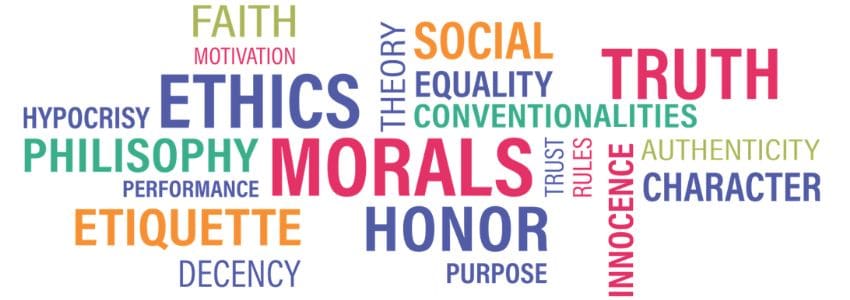
HR Question:
I’m a new supervisor. Now that I have oversight of my team, I know it’s my responsibility to keep an eye out for unethical behavior. But what does that behavior look like? How can I prevent unethical conduct on my team?
HR Answer:
Ethics in the workplace can be a broad and, at times, intangible concept. At its root, unethical business practices include any behavior that violates the law, such as theft or violence, but can also include areas that are broader and more nebulous. According to The HR Digest, the five most common examples of unethical behaviors are:
- Employee theft. In 2012, one out of every forty employees was caught stealing from the workplace.
- Misusing company time. This may include an employee who spends the entire morning placing orders on Cyber Monday or a co-worker who clocks in for an employee who shows up late.
- Verbal abuse. This can include bullying co-workers or subordinates or harassing employees.
- Lying in the workplace. An example could be a sales employee who tells customers that a defective product has a flawless reliability record.
- Taking credit for someone else’s work. This could be an employee who takes credit for a co-worker’s idea for a process improvement and receives a bonus for a job well done.
Is Unethical Behavior Really That Common?
Studies suggest that unethical behavior is something that all managers must confront at some point in their careers. To illustrate this point, in HR Ethical Dilemmas by the Society for Human Resources Management, 30% of surveyed U.S. employees said they felt pressured to compromise their workplace’s ethics, a 14% increase from three years earlier. Almost half of those employees surveyed said they observed misconduct that violated their organization’s ethics standards.
The risks of unethical behavior in business can be devastating. For instance, bad corporate behavior can lead to the loss of valued employees and can discourage new recruits from applying. Employees want to work for a company that has values that align with their own personal values. They’re even willing to take a pay cut for it, as evidenced by MetLife’s recent study that found 89% of employees are willing to trade some of their salary (an average of a 21% pay cut) to work at a company whose values match their own.
But the impact isn’t just felt internally, as customers’ decisions can also be impacted by unethical behavior. According to Accenture’s Global Consumer Pulse Research, 62% of consumers consider a company’s ethical values and authenticity before making their purchasing decisions. Finally, unethical behavior can carry with it legal risk, resulting in fines, penalties, and even incarceration.
How Can a Company Prevent Unethical Behavior?
Companies can take steps to prevent unethical and unlawful behavior. This includes the following steps:
- Establish a Code of Conduct. Business leaders, including HR, must establish clear statements that define a company’s values, principles, and conduct.
- Train every employee on the company’s values, principles, and code of conduct. Training should be done in a way that helps each employee to see how their work and behavior support these principles.
- Establish a means for reporting unethical behavior. One of the most effective ways of enabling employees to report workplace ethics violations is to establish a 24/7 hotline that allows employees to report concerns anonymously and without retaliation. Those staffing the hotline should be a third-party, or employees who are removed from operational management. Concerns should be reported directly and confidentially to a senior executive or, in some cases, to a designated Board member.
- Include a question on business ethics in your employee engagement surveys. If employees respond less than favorably to this question, find out why through focus groups or department meetings.
- Share your Code of Conduct with your clients and suppliers. Let them know the company will abide by the Code while working with them. Provide them with a means to share feedback on any concerns regarding business ethics while working with the company.
As a supervisor, it goes without saying that your team is likely to emulate the behavior that you model. Therefore, it is important that you uphold the company’s values and Code of Conduct in your own behavior and ensure that your team members receive the appropriate training and understand the ethical standards they are expected to maintain.
Special thanks to Terry Wilson, SHRM, SPHR-SCP for writing this edition of our HR Question of the Week!
Have a new supervisor on your team? Put them on the road to success by signing them up for our Supervisor Training Series! Visit our Training and Development page to learn how we can help your management team to get off to the right start.
How Do I Write and Deliver a Written Warning?
Last Updatedin Recordkeeping

HR Question:
I have an employee who is not following company policy. I have given them several verbal warnings, and I know my next step is a written warning. How do I write and deliver a written warning?
HR Answer:
Disciplining employees can be uncomfortable. That’s why most companies have a Progressive Disciplinary Policy, clearly stating the steps employees need to take to modify unacceptable behavior and achieve the expectations of their role within the company. This can take the burden of deciding the next steps or consequences off of the manager and help them maintain an unbiased disciplinary process.
In order for the Progressive Disciplinary Policy to work as designed, it’s important that managers and supervisors document incidents appropriately. By following this policy and documenting incidents accordingly, companies can make a case for discipline or termination. However, without the appropriate documentation, taking disciplinary action can be potentially risky.
How Do Progressive Disciplinary Policies Start?
Most Progressive Disciplinary Policies start with a verbal warning. It’s important to make sure the employee is aware of what policy they are not following, as sometimes it’s simply a case of not being aware. It’s the “human” part of “human resources” – sometimes, employees make honest mistakes when they aren’t aware that they’re not in compliance. A verbal warning here can do the trick. However, sometimes it takes more than a verbal warning. That is when a written warning comes into play.
What’s Next? A Written Warning.
A written warning is a more formal step in the disciplinary process. A written warning should include:
- Employee Name
- Position
- Expectations
- Details of failed expectations
- Consequences of failing to improve
- Employee comment section
- Manager signature/date
- Employee acknowledgment
It’s important to include factual information should the process or the disciplinary action ever be called into question. Additionally, any emotion or opinions should be kept out of the written warning and subsequent documentation.
The Do’s and Don’ts of Writing a Warning
Susan Heathfield, a writer for Balanced Careers, shares the following excellent examples of the right and wrong ways to document an attendance issue in The Importance of Documentation in Human Resources:
Wrong:
“Mark is usually late for work. Mark misses too much work.”
In this example, the documentation lacks specific examples, dates, and times, and includes the supervisor’s opinion, making a poor case against the employee and a strong case for discrimination or targeting by the supervisor.
Right:
“April 1: Mark called in sick and missed eight hours of work.”
“April 4: Mark arrived at work at 10 a.m., two hours late from his scheduled start time.”
“April 6: Mark scheduled a doctor’s appointment and then, stayed home to have a new furnace installed.”
“April 12: Mark called in sick and missed eight hours of work.”
See how the documentation relies on dates, times, and the amount of work missed? It also details the specific reasons the employee was missing work, rather than letting those facts be forgotten or muddled when recalled later.
Best Practices for Written Warnings
Like most processes in business, there are best practices when it comes to delivering written warnings. First, it’s important to be consistent and timely. Avoid waiting days or weeks to write up an employee for an issue, as the impact of the warning (as well as the clarity of each person’s memory) can fade with time. Additionally, if you write up one employee for an attendance issue, be prepared to write up others who have the same issue. This consistency can help prevent claims of discrimination or favoritism.
At the end of the day, it’s important to provide feedback to your team members to help them succeed. If the employee has improved, be sure to acknowledge their effort. If the employee has not improved in the time allowed, continue to follow your Progressive Disciplinary Policy.
Special thanks to Sherri Hume, SHRM-CP and Samantha Kelly for contributing to this HR Question of the Week.
Employment recordkeeping does not rank high on the list of favorite human resources responsibilities, but it can get you into hot water if not done properly. Keeping appropriate disciplinary documentation is vital to proving your processes are compliant. Avoid the fines and minimize your stress level by having Strategic HR assist with your recordkeeping compliance. Visit our HR Compliance and Recordkeeping page to learn more about our services.
How Can I Improve My Recruitment Processes?
Last Updatedin Recruitment

HR Question:
We’re in desperate need of the right talent, but I can’t seem to attract or engage the number of candidates I need! How can I improve my recruitment processes to attract more candidates?
HR Answer:
You’re not alone! Recruiting the right talent is a challenge in almost every industry and market right now. Because the competition for candidates is incredibly tight, employers everywhere are looking internally to find ways to improve their recruitment processes to catch more prospective employees. By eliminating barriers for candidates and making the job search and application process engaging, efficient, and user-friendly, employers can see an increase in their candidate flow, further increasing the likelihood of finding the right candidates for their organization.
So, let’s dive in to identify what employers can do to attract more candidates – without losing them during the application process.
Optimize Your Job Ad
First, make sure your job ad is designed to show off your company by highlighting the areas that candidates want to know more about – the culture, the day-to-day, what success looks like, and why they would want to join your organization. What makes you stand out against your competition? Take note of these reasons and work them into the ad, as just placing your job description on your company’s career page is not likely to attract many candidates. Paint the picture of your company and the open role with clear and concise language, limited bullet points, and the key requirements of the position.
Consider researching similar positions in your area for popular job titles to make sure you are not reducing your audience by titling your position something unfamiliar to your target applicant pool. For example, don’t name your Customer Service Representative a “Client Wizard” or “People Pleasing Person.” While the titles may bring a smile to your face, they won’t show up in basic keyword searches.
Although it may cause some hesitation, it is also recommended to include the salary range in your job post, even if it is a broad range. Research has proven that candidates are more likely to apply if they know the compensation range, and it eliminates time down the line by not considering candidates significantly out of range.
Cast a Wide Net to Attract More Candidates
Now that your job ad is written, it is time to get the right eyes on it! In order to make sure you’re spending your time and money to optimize your return on investment, take some time to do a brief search of where similar positions are being advertised. Check out any applicant stats that the job board may highlight about those roles. How many people have applied? How long has it been posted? Are there other similar positions posted on the site? This will help you understand if this is where your desired audience might be found.
If you have the budget to advertise your job, use it. If not, there are also online recruitment platforms where you can post your positions for free, most of which take little time to use and can help with visibility. You can also look for local, county, or state job networks where you can share your position for free. You may want to consider joining some professional associations or alumni groups on LinkedIn and Facebook that align with your organization so that you can share your open positions. You can also use your involvement in these organizations and groups to build a network from which you can source current and future candidates.
Keep It Simple
Once you have a candidate interested, it is important to make your application process as simple as possible. Keeping the process short and simple will help convert the number of views of your job into completed applications. Mobile-friendly application processes are now “a must,” rather than considered “nice to have.” In fact, almost 60% of job seekers apply via a mobile device, so having a long application results in fewer completed applications.
Several job posting platforms allow candidates to apply with one click, which has become an increasingly popular option for applicants and recruiters alike. If you do require an application, first make sure it is mobile-friendly and that your system can auto-populate employment history from the applicant’s resume. Any additional screening questions should be yes or no questions and only those things that are essential to the position at the application stage in your process (i.e., age requirements or required certifications). Save any other questions for later in the recruitment and hiring process.
If you want to improve your recruitment processes, it won’t necessarily require a full overhaul of your entire department. Particularly when departments might feel stretched thin or understaffed, simplifying the steps required and creating targeted materials can make the process easier on both the recruiter and the candidates. Consider taking some time today to review your processes and find ways to simplify your steps!
Special thanks to Lisa Johnson, CIR, and Samantha Osborne Kelly for contributing to this HR Question of the Week.
Recruitment is more than just posting a job ad. It takes a targeted message, the right sources, and lots of follow-up. But recruiting doesn’t have to take up all of your time and money! Our team at Strategic HR knows what it takes to attract, hire, and retain the best employees. Check out our Outsourced Recruitment page to learn more or contact us for recruiting help!
Do Our Remote, Out-of-State Employees Qualify for FMLA?
Last Updatedin HR Compliance

HR Question:
Our company has employees located in Ohio who all qualify for the protections covered under the Family Medical Leave Act (FMLA), but we also have employees working remotely in other states. Do our remote, out-of-state employees qualify for our FMLA policy?
HR Answer:
Great question. Even if the employees don’t fall within the 75-mile radius that the FMLA takes into account when counting employees towards the requirements, employers are still required to provide FMLA benefits to their employees who work remotely and out-of-state.
Why Does FMLA Compliance Matter?
What happens if those same benefits aren’t extended properly? Well, a lack of FMLA compliance can result in impressive fines. For example, not completing the notice can cost several hundred dollars alone, not to mention the millions in fines that can result from a mishandled claim or wrongful termination, such as the situation this Massachusetts company found itself in.
Even before the COVID-19 pandemic struck, some companies were beginning to branch out of their home states and hire individuals with the necessary talent, but not necessarily the ideal location. Many of these organizations were pioneering the process, working through the requirements and laws as they could. Now that remote work has become such a staple in the business community, it’s easier for any organization to run into this issue, as it’s often the case that many remote employees may be the first or only employee in a particular state.
How to Determine if Remote Employees Qualify for FMLA
There have been no changes to what is defined as “covered employers” as defined by the Department of Labor (DOL), as a “covered employer may be a private-sector employer (with 50+ employees within a 75-mile radius in 20 or more workweeks in the current or previous calendar year), a public agency, or a school.” Employers that fall under this category are required to provide FMLA benefits and protections to eligible employees while also complying with additional responsibilities required under the FMLA.
An eligible employee is one who:
- Works for a covered employer,
- Has worked for the employer for at least 12 months as of the date the FMLA leave is to start,
- Has at least 1,250 hours of service for the employer during the 12-month period immediately before the date the FMLA leave is to start (a different hours of service requirement applies to airline flight crew employees), and
- Works at a location where the employer employs at least 50 employees within 75 miles of that worksite as of the date when the employee gives notice of the need for leave.
So why does this rule extend to those employees who fall outside of the 75-mile radius and the 50+ employee count? It’s because the DOL determines their FMLA status based on the office or location that delivers their assignments or that they report to. The purpose of this is to protect the employees’ jobs should they have the need to focus on their own or their family’s health.
If you assume that you don’t have to meet FMLA guidelines for a remote employee, be sure to double-check the Department of Labor’s regulations, as well as your own internal reporting system, before skipping this important requirement.
Special thanks to Alisa Fedders, MA, SPHR, and Samantha Kelly for contributing to this edition of our HR Question of the Week!
FMLA, ADA, and other labor laws can be difficult to understand – let alone enforce. That’s where Strategic HR has you covered. We bring years of experience and know-how to the table. We can assist you with your tough compliance issues and help you sleep more soundly at night. Visit our HR Compliance & Recordkeeping page to learn more.
Should We Abolish Performance Improvement Plans?
Last Updatedin Employee Relations

What is a PIP?
A performance improvement plan (or PIP), as defined by the Society for Human Resource Management (SHRM), is a tool utilized specifically to provide employees with an “opportunity to succeed,” rather than lose their job. PIPs provide two important features: first, to provide a timeline for improvement; and second, to create documentation of performance-related discussions. This means PIPs can be for anyone in the organization – strong performers, over-achievers, under-achievers, executives, or entry-level employees.
Organizations utilize PIPs in order to provide a clear path to success in partnership with an employee’s manager. Particularly in a difficult or limited candidate market, PIPs are best utilized as a retention tool to re-engage and improve an employee’s performance before the relationship between the employee and employer is beyond repair. However, that’s not always the case.
In early 2022, LinkedIn News published an article encouraging a revolution or reevaluation of performance improvement plans. Many employees identified the negative connotation that they associate with PIPs, arguing that they saw PIPs being used to “manage an employee out” of an organization, rather than being used to provide developmental opportunities to address goals or performance. In fact, some volunteered their own experiences of meeting or exceeding expectations, only to be placed on a PIP when there were internal disagreements or frustrations, encouraging the employee to look elsewhere for a job.
So should organizations abolish the use of performance improvement plans altogether? Or are there ways that we as HR professionals can improve the PIP process to utilize the process correctly and better serve our employees?
Ask Yourself “Why?”
As mentioned earlier, the goal of a PIP is to be used for developmental reasons (i.e. should there be performance goals to meet or behaviors that need to be changed for a successful and harmonious workplace).
As organizations take a closer look at how they utilize a PIP, it’s important to first ask why it may be necessary. Is the employee in question failing to meet performance goals? Or is there a behavior-related concern that’s impacting the workplace? A performance improvement plan may be appropriate here, as long as the intended result is an achievable improvement in a reasonable about of time.
If the answer to “why” is to eliminate a person from the organization, or encourage their resignation, then the PIP is being misused. Sometimes, organizations may utilize PIPs if they don’t have other ways or disciplining or managing poorly improving employees who aren’t a fit for the company. If that’s the case, the solution isn’t a performance improvement plan, but a clearly laid-out warning/discipline process instead.
Clearly Define Your Plans and Language
Some managers use the PIP because it doesn’t sound disciplinary when they’re really trying to manage someone out. As a result, the term has gained a negative connotation because it’s been used as a way to punish instead of encouraging to improve. The term “PIP” has even gained such a negative connotation that employees may immediately start looking at other roles for fear that termination is right around the corner.
To alleviate employee concerns and refocus employees on the real goal of a performance improvement plan, consider changing the language around the PIP. Maybe, instead of a “performance improvement plan”, consider calling it an “individual development plan.” After all, the goal is to refocus both the manager and the employee on the person and their individual success, rather than focusing solely on performance. This allows the tool to be used for anyone at any time – not just when there needs to be a marked performance improvement. By asking questions such as “how do you want to improve, how do you want to grow, how do you want to better yourself?”, managers can turn the implication of performance improvement plans around from “impending termination” to “invested growth.”
But, suppose the goal is truly to encourage an employee to consider another career path or to cut ties. In that case, it’s important to clearly define the language you plan to use while having an honest conversation with the employee and implementing a disciplinary form. Being sure to include an escalating path of written and verbal warnings, performance meetings, and deadlines will make terminations easier from a documentation and expectations perspective.
Timing (Implementation)
We owe it to people to coach and develop them before it’s too late. It’s uncomfortable to have frank conversations about performance, and most people prefer to look away until it’s too bad to ignore. But it shouldn’t be negative – feedback is a gift. There are so many people who don’t give feedback and expect them to read minds.
As in any coaching instance, it’s important to deliver the feedback – good or bad – as close to the instance the action happened as possible. But how you deliver it in the moment can be key. If the message comes from a place of truly caring about the person and wanting them to improve – be it their performance, approach, or level in the company – that should come across. And by being sure to use a coaching tone in the conversation rather than a disciplinary one, encourages employees to become invested in their own improvement rather than fearing being “caught doing something wrong.” In the end, it’s about assessing and respecting the difference between corrective action (which doesn’t have to be negative) and disciplinary procedures.
In this candidate-driven market, it’s difficult to find the talent that you need to continue to grow your business. Retention tools, such as performance improvement plans, can help you fully utilize and elevate your employees to greater heights (when used correctly). As you continue to assess your employee relations and development tools, consider re-evaluating how you might use performance improvement plans and disciplinary action to best support your employees and your company’s strategic goals.
Thank you to Cecilia Vocke, MS, SHRM-SCP, SPHR for contributing to this Emerging Issues in HR.
Strategic HR understands the value of retaining your workforce through good Employee Relations. We’ve helped companies nurture their cultures by designing/updating employee handbooks, creating reward and recognition programs, providing training for safe and productive workplaces, gathering feedback through employee surveys, pulse surveys, focus groups, and more. Learn more about our Employee Relations Services, or contact us.
How Can You Teach a Manager to be a Good Listener?
Last Updatedin Communications

HR Question:
I’ve received a couple of complaints about one of our managers because he is quick to jump to conclusions and doesn’t listen well to his team. I want to provide him with some coaching on active listening. Can you offer suggestions on how to teach him to be a good listener?
HR Answer:
How many times have you walked away from a conversation with someone, whether it was your boss, co-worker, friend, or family member, saying “they just don’t listen to what I am saying!”? This is a common frustration for many, and it happens for a variety of reasons. Whatever the reason, it causes dissatisfaction and can lead to hurt feelings or feelings of distrust.
Listening is a leadership skill that is rarely taught, yet it is a critical one for managers. And listening is getting more challenging in the world of remote employees, remote customers, and remote meetings. In more than thirty leadership and HR articles published on our website alone, listening is cited as an important component in the advice, training, or program being recommended. So, as you look to provide active listening coaching, you want to help the manager to understand both why it is important and how to become a better listener.
Why Listening Skills Matter
The ability to make others feel valued for their contributions to a project, a team, or an organization as a whole is a reflection of an effective leader. Being a good listener and ensuring that employees feel heard is essential in developing trust, respect, and loyalty.
In a recent Fast Company and the Harvard Business Review dive into science-based, specific steps on how to become a better listener. To break down their suggestions to the barest components, both sources recommend these basic essential steps:
- Be Quiet
- Listen
- Repeat
Sounds easy, right? But what do each of those steps really entail? To implement them correctly, you must:
- Focus all of your attention on the other person. Stop what you are doing with your computer, phone, or even distracting thoughts from a previous conversation running through your head. Use all of your senses to focus on what the person in front of you (in person or on-screen) is saying.
- Use non-verbal cues to communicate that you are listening, like making eye contact and nodding your head. Also, pay attention to the speaker’s non-verbal clues to see if they are congruent with the words they are saying.
- Remain calm and control any emotional response you have to what they are saying. Allow them to finish their statements before you say anything in response, and do not plan your response in your head while they are still talking. Listen to everything they have to say first.
- Restate the last few words they said, and clarify what you believe they were saying. Ask follow-up questions. If the person’s words do not match the non-verbal signs the speaker is giving, carefully inquire about the differences.
- Finally, make sure you understand why they shared this message with you, and if you do not, then ask. A good listener seeks to understand the speaker’s intent, i.e., were they just venting, were they sharing an accomplishment and they need praise, or do they expect you to take some action as a result of what they shared?
Active Listening Enhances Your Professional and Personal Life
It takes practice to be a good listener. It may come more naturally for some than others, but it is a skill that everyone can develop. As you work on finetuning the skill, ask for feedback about how well you listen… and listen to the response! Listening is a skill that will not only enhance your communication and leadership at work, but it’s valuable in your personal life as well. Working on your active listening skills will be time well spent – your employees, friends, and family will appreciate your efforts.
Thank you to Lorrie Diaz, MS, for contributing to this HR Question of the Week.
Carefully choosing the right words and the best approach can make the difference between achieving your goals or having your efforts go awry. Managing your HR Communications doesn’t have to be hard – as long as you have the right tools and training. Learn more about how Strategic HR can help with your HR Communications or contact us about your needs.
What are the Newest Benefit Trends?
Last Updatedin Benefits & Compensation

HR Question:
We’re trying to review our benefit offerings to make sure that we’re meeting each of our employees’ needs. We’re able to offer the basics – health, dental, vision – but are there offerings we haven’t considered yet to keep up with benefit trends?
HR Answer:
In today’s market, it’s as important to retain the talent that you have as it is to recruit the right talent. The conversation around retention has offered employees a greater opportunity to be more vocal about their individual needs. So, what innovative employee benefits trends are employers implementing to retain their workforce and catch the eye of necessary talent? How can employers structure their benefits package with offerings that are appealing and beneficial to each employee?
Now more than ever, employees consider benefit offerings as an essential part of their compensation packages. While it’s obvious that employers can’t offer the sun, moon, and stars, employers can survey their teams to understand the benefits that would truly make a positive impact in their lives (and hopefully retain these employees longer). The results may surprise you, as it’s possible only a few adjustments need to be made to meet the wants and needs of your workforce.
For example, consider these four trending areas to enhance benefits and voluntary options to accommodate employee wants and needs: mental health, policies to support neurodiverse employees, support for life-changing diagnoses, and financial assistance.
Mental Health
Mental health remains one of the most talked-about and pressing benefit trends of this year. Even though the COVID-19 pandemic has receded to levels that allow for a partial return to normal, the impact on mental health remains. Many employers are turning to partnerships with apps like Calm or Headspace, while others (such as Clark Schaefer Hackett) have taken the opportunity to extend their Employee Assistance Programs (EAPs) to cover their employees’ extended family members, such as siblings and in-laws.
Policies to Support Neurodiverse Employees
It has been proven that diverse workforces naturally perform better. But diversity goes beyond race, gender, or age – it can also apply to thinking styles, abilities, and problem-solving practices (also known as neurodiversity). By creating inclusive policies and benefits for neurodiverse individuals – such as people with autism – organizations can open their doors to additional talent, unique perspectives, and innovative individuals, creating even greater diversity and inclusion in their workplace.
Support for Life-Changing Moments
As the conversation around work/life balance ebbs and flows between a balance and an integration, many would agree that personal life priorities impact performance, focus, and success at work. Offering support for moments such as cancer diagnoses and care programs (such as cancer insurance or critical illness insurance) or addressing the needs of female health (such as time and flexible work hours to deal with symptoms of menopause or fertility needs), miscarriages, or adoption needs can go a long way in addressing the work/life needs of your employees.
Financial Assistance
According to Schwab Retirement Plan Service’s annual survey, 48% of participants found themselves more likely to save more in general due to the pandemic, with over 85% listing a 401(k) plan as a “must-have” benefit. If 401(k) plans fall outside of what your organization can provide, consider offering smaller but still impactful benefits such as reimbursements for work-at-home expenses, stipends for child-care support, or programs to support emergency savings, debt management, and budgeting.
While healthcare costs continue to rise amongst the “Great Resignation” waves, employers are not without ways to attract and retain a larger percentage of their employees – starting with their benefit offerings.
Thanks to Janine Cummings, SPHR, SHRM-SCP for contributing to this edition of our HR Question of the Week.
Strategic HR has the answers to all of your tough Benefits and Compensation-related questions. Please visit our Benefits & Compensation page for more information or contact us to troubleshoot today.
Four Ways to Improve New Hire Onboarding and Training
Last Updatedin Training & Development

HR Question:
Currently, our onboarding includes completing new hire paperwork, going over our company history and policies, ensuring they have the necessary technology tools, and having them meet with select employees to learn what they need to learn to hit the ground running. What else should we incorporate to improve our new hire onboarding and training?
HR Answer:
It sounds like you’re off to a great start. Just to be sure that you’re covering the basics, you should check out these key components of an onboarding plan. To move beyond the basics, I’m going to offer four additional, yet sometimes overlooked, ingredients that can greatly improve the effectiveness of your new employee onboarding:
1. Plan the Right Duration for Onboarding
Developing a solid understanding of how an organization operates, as well as understanding the significance of an individual’s role within it (all while building long-term work relationships), takes time. In some organizations, employees are provided one to three full days of onboarding during their first week. In these situations, they typically review and complete new-hire paperwork and benefit plan enrollment forms, review the safety, health, and security components of the job, and complete any other critical training to be able to hit the ground running. However, is this sufficient onboarding to create a long-term employee? Adult learning research would suggest that it isn’t enough.
Effective adult learning practices must provide opportunities for observation, asking questions, and putting facts, ideas, and experiences together to derive new meaning. This can take time, especially when your goal is to develop a clear understanding of company values, culture, and team cohesiveness and effectiveness. So, if you’re looking for ways to improve your onboarding process, be sure you allocate an appropriate amount of time to the process.
We recommend breaking the new employee learning process into two phases: 1) Employee Orientation and 2) Employee Onboarding.
Employee orientation may take place during the first week of employment and include a company tour, introductions to key staff, new hire paperwork, and cover the basics of the new worker’s job, payroll, benefits, company policies, and safety.
Employee onboarding may start within the employee’s first week and take place over several weeks or months, depending on your goals. In the course of onboarding, you may focus on company culture, values, and team development by having the new hire meet one-on-one with team members to learn about various functions within your organization and how they will play a role in them. You may provide additional specialized training to ensure your new employee is set up for success in their position.
Keep in mind that the volume of new information can be overwhelming for new employees, so you should prioritize and plan appropriately for what information, training, and experiences they need to have from the beginning versus the weeks or months down the road.
2. Design Training for Different Learning Styles
Adults have different preferences on how they learn known as learning styles. Although you might be inclined to develop training based on how you learn best, a valuable way to improve your onboarding and new employee training is to keep your employees’ needs and learning preferences top of mind. A common model for learning styles is the VARK Learning Model which illustrates four key ways that people prefer to learn:
Visual Learners – Prefer to see information. They learn best if they are shown pictures, charts, graphs, or videos to learn important information and details.
Auditory Learners – Prefer to hear the information rather than see it. They prefer to ask questions and repeat back what they have learned.
Reading/Writing Learners – Prefer detailed, written instructions with opportunities to add notes and highlights. They learn best by writing things down to process the information.
Kinesthetic Learners – Prefer to learn by doing. They learn best when they can do “hands-on” work or try to complete a project or task even if it involves trial and error.
Many people actually prefer a combination of these learning styles to meet their learning objectives. Recognizing this can help HR and/or supervisors to tailor their training to each individual. Training Magazine recommends using a differentiated training approach designed to accommodate the different ways that employees learn – ensuring that everyone has an equal opportunity to learn. HR professionals or supervisors can discover employee learning styles by simply asking them how they prefer to learn new information. If you’re providing training for a group, be sure to incorporate a multi-faceted approach.
3. Incorporate Coaching and Mentoring
A supervisor must provide ongoing and frequent coaching to ensure that knowledge and skills are transferred effectively following training. In addition, assigning a “mentor” or “buddy” can provide a huge boost to a new hire’s onboarding and long-term experience in your organization.
Generally, the role of a mentor is to offer the new employee a connection to someone who can guide him or her but is not in a position of direct authority over the new hire. The Business Journals touts the importance of mentors recognizing how they help new employees to quickly apply their new skills while also relieving some of the new employee’s anxiety.
Mentors may be paired with a new employee for as little as a day or as long as a year, depending on the length of the onboarding program. Their responsibilities may range from providing practical information such as directions to the restrooms, cafeteria, or parking places, to helping the employee understand the nuances of working in the organization. Mentors can also help to make meaningful connections within your organization and answer questions that the new employee may not feel comfortable asking of their supervisor.
4. Evaluate the Effectiveness of the Onboarding Experience
The best way to know whether your onboarding experience is truly meeting the needs of your new hires and your organization’s goals is to ask those who were involved. At a minimum, the new employee should be asked how their onboarding experience is going and whether there are components that should be added, removed, or tweaked. They are likely to provide great ideas for how to improve the onboarding process.
Verbal evaluations can be accomplished between the new hire and their supervisor during our recommended touch bases after 1 week and at 30-60-90 days from the new hire’s start date, or you can choose to ask for feedback via email or other internal communication software/tools. You should also solicit feedback from anyone who was involved with facilitating training and/or serving as a mentor.
No matter what method you choose, it will be important to get feedback from those who are involved in your onboarding process to ensure that it is meeting the employees’ needs and expectations as well as organizational goals.
Thank you to Terry Wilson, SPHR, SHRM-SCP for contributing to this HR Question of the Week.
You need your new hire’s onboarding and training to be an excellent experience. Because let’s face it, in this labor market, you can’t afford for it not to be. Strategic HR can provide the support you need with all of your Training and Development goals. Contact us to see how we can help.
What’s the Most Effective Way to Use Panel Interviews?
Last Updatedin Recruitment

HR Question:
As a retention and growth opportunity, we have decided to shift to panel interviews to engage our team members in the hiring process. What’s the most effective way to use panel interviews?
HR Answer:
Panel interviews, when planned properly, can greatly exceed the effectiveness of single interviewer methods.
Why Single Interviewer Methods Can Be Difficult
From the perspective of an interviewer, conducting an effective interview can be a challenging task. The interviewer must concentrate on asking good questions and listening to the candidate’s responses. At the same time, the interviewer has to formulate an appropriate follow-up question, monitor how much time is left, jot down interview notes and, most importantly, pay close attention to both verbal and non-verbal responses of the interviewee. These tasks altogether create distractions that cause an interviewer to miss important cues from the candidate.
Panel interviewing addresses the shortcomings of the single interviewer method. As the Society of Human Resources shares, panel interviews allow interviewers to get a broader picture of the candidate and their experience while observing the candidate’s verbal and non-verbal responses and taking good notes. From the candidate’s perspective, it can significantly reduce the amount of time that they must spend interviewing with the employer as compared to interviewing with several employees separately.
How to Build an Effective Interviewing Panel
The interview panel generally should consist of three to five members with one of those individuals playing the role of panel facilitator. Whenever possible, the panel should represent the diversity of your organization. Although the specific individuals selected to participate on an interview panel will most likely change based on the positions you are seeking to fill, once a panel is selected for a particular role, the members of that panel should stay consistent until the position is filled. Panel members should receive training on effective interviewing techniques and be briefed in advance regarding their role in meeting with the candidates.
Before each interview, the panel facilitator will be responsible for a few tasks, such as assigning questions to each panel member, establishing the expectations of the panel, briefing the panel on certain areas for more emphasis or depth of questioning depending on the candidate’s situation, as well as distributing the materials to be used by the panel — candidate resume, application, interview guide, job description, etc. Ideally, these materials should be provided ahead of time for each panel member to review in advance.
During the interview, the facilitator will introduce the candidate to the panel, monitor time and, after the candidate has departed, lead the evaluation and consensus rating of the candidate. Preferably, panel facilitators should have good leadership skills, interviewing experience, and consensus-building skills.
The “Flow” of an Effective Panel Interview
The best panel interviews follow a sequence that allows panel members to get the most information from the candidate. Effective panel interviews will naturally follow the same steps.
First, introductions are made by the main facilitator, who will also detail the process for the candidate. The facilitator should let the candidate know there will be time for their questions at the end, so the candidate can feel at ease.
Using the same interview guide, the facilitator and other panel members will take turns asking questions of the candidate. It’s important that other panel members remain silent and take note of the candidate’s responses when it isn’t their turn to allow the candidate to focus on responding to only one person, as well as to make sure they’ve accurately captured the candidate’s thoughts. Once the panel members’ and candidate’s questions are answered, the facilitator will tell the candidate what to expect next and will escort the candidate from the interview room.
Afterward, the facilitator will lead the discussion on the candidate’s responses, qualifications, and ratings for each area questioned during the interview. Panel members will discuss their ratings, point out the basis for their evaluations, compare their decisions, and support their observations. Finally, a consensus on next steps should be reached.
The Importance of Reducing Candidate Stress
The most effective interviews provide candidate responses that are candid and thorough. Candidate stress can inhibit straightforward responses and reduce the effectiveness of the interview. Therefore, a genuine attempt should be made to put the interviewee at ease. This can be done in several ways, such as:
- Giving the candidate enough warning that this will be a panel interview, along with background information on each panelist to help the candidate have a better idea of who they will be meeting with.
- Avoid seating panel members behind a massive table or facing the applicant as if it were an interrogation or a trial by jury.
- Make sure that each interviewer finishes asking all of their assigned questions before others ask follow-up questions. Without this, the candidate may feel interrogated rather than engaging in an open dialogue.
Special thanks to Terry Wilson, SPHR, SHRM-SCP, Senior HR Business Advisor for contributing to this edition of our HR Question of the Week!
Could you use some help in recruiting the best talent for your organization? Learn about our Recruitment Services, or better yet, Contact Us to find out how we can help.
Do I Have to Give Performance Bonuses to Employees on FMLA Leave?
Last Updatedin Benefits & Compensation
Top 3 Reasons Why New Hires Leave… And How to Turn Around Your Turnover!
Last Updatedin Employee Relations, Recruitment
Specific Ways HR Can Cultivate an Inclusive Workplace
Last Updatedin Employee Relations
HR Question:
We’re celebrating the last full week of Black History month, and we want to keep the conversation going. How can our HR department cultivate a more inclusive environment beyond Black History Month?
HR Answer:
While the month of February inspires us to celebrate the successes and recognize the struggles of Black and African American individuals across the US, this focus and spotlight do not have to (and we’d argue should not) be limited to four weeks out of the year. In “The Diversity and Inclusion Revolution,” one of the eight truths the Deloitte Review focuses on is that to create a diverse and welcoming workplace, organizations have to “perform a culture reset, not a tick-the-box program.” Celebrating the work and contributions of Black Americans during one month is not enough to build a diverse culture – rather, it can contribute to a continuous, inclusive facet of a larger and ongoing conversation; one that includes a wide range of abilities, identities, ethnicities, races, and genders.
Studies have shown that increasing the diversity of teams and leadership leads to increased innovation. Additionally, it’s no secret that diverse, inclusive, and equitable workplaces see higher than average financial performance as well. It is easy to see why cultivating an inclusive workplace is not only the right thing to do; it is also a smart business decision. So as you look for ways for HR to continue to nurture and grow a more inclusive environment beyond February, we offer the following suggestions.
Embrace 3 Pillars of Diversity and Inclusion
After studying the most productive workplaces around the world, Gallup identified three requirements for a diverse and inclusive workplace culture:
- Employees are treated with respect
- Employees are valued for their strengths
- Leaders do what is right
By viewing diversity and inclusion through a broader lens as Gallup has, it opens the door for everyone to see how they can play a role. It’s naturally HR’s role to facilitate open conversations amongst employees, managers, and executives, including facilitating eye-opening and bridge-building conversations about how to understand and respect one another’s differences and the value that these differences can bring to our professional and personal lives.
In addition to having meaningful conversations that foster a respectful and inclusive environment, we recommend that you review your employee handbook to ensure that your policies and practices fully support diversity and inclusion in your organization. For example, do you have a clear path for employees to go to HR should they have concerns about the inclusivity of their workplace?
Provide Training that Meets Employees Where They are in the Journey
As your organization continues to foster a culture of inclusion and belonging for everyone, it’s important that your employees have the tools and common language to talk through related topics and issues together. When it comes to understanding diversity and how we can learn from one another, there is not a lack of potential training and development experiences. No matter where your employees are on this journey, it is important to continue to provide education and opportunities for growth. If you don’t feel that you are best equipped to educate employees on the subject matter, you may feel inclined to bring in a reputable speaker or training facilitator to optimize the experience.
Look for Ways to Foster a Sense of Belonging
There are many ways that HR can be purposeful in cultivating an inclusive culture. You can look for opportunities throughout the year to recognize important dates or impactful cultural events and help employees to celebrate them. For example, Juneteenth was recognized as a federal holiday beginning in 2021 – does your organization have plans to celebrate, recognize, or highlight the holiday? Can your employees take time off through established or floating holidays without utilizing their PTO in order to celebrate?
With the goal of creating an inclusive environment, consider providing forums and welcoming spaces for members of various affinity communities to exchange ideas, find mentorships, encourage a sense of belonging, and network. These groups could range from different ethnic and cultural backgrounds to LGBTQIA2S+, women, young and emerging professionals, and more. For example, look to GE’s Employee Resource Groups, which exist for the purpose of welcoming “all employees to learn, connect, advocate, and foster a sense of belonging.”
Get Involved in Your Local Community
As the Deloitte Review emphasized, “match the inside and the outside.” Internal efforts to continue the conversations emphasized during Black History month or other diversity and inclusion initiatives can be more effective when matched with external efforts to make a difference in your local community. Look for outside opportunities through community action groups or nonprofit organizations. You could also consider paying employees for their time and efforts contributing to a more inclusive and welcoming society.
As we mentioned, there are countless ways that HR can cultivate an inclusive workplace, so we hope that these suggestions inspire even more ideas for how you can nurture diversity, equity, inclusion, and belonging in your organization.
Thank you to Mary Mitchell, MBA, SPHR, CHRS; Melinda Canino, MS; and Samantha Osborne Kelly for contributing to this edition of our HR Question of the Week.
Having an inclusive organizational culture that contributes to your organization’s overall success doesn’t happen by accident. It needs to be nurtured. Learn how we can help you to nurture your culture through our DEIB Consulting Services, or contact us today.
Who Has to Submit OSHA Form 300A?
Last Updatedin Health, Safety & Security, HR Compliance, Recordkeeping
How Can I Use Salary Benchmarking As a Recruitment Strategy?
Last Updatedin Benefits & Compensation, Recruitment
How Do We Create An Emergency Preparedness Plan?
Last Updatedin Health, Safety & Security
HR Question:
We don’t have a formalized emergency preparedness plan, and I think we should probably have one, right? What should we include?
HR Answer:
You’re right. Every employer needs an emergency action plan for many reasons, including to be compliant with the Occupational Safety & Health Administration (OSHA) 29 CFR 1020.38(a) requirement. Beyond the mandate, every employer should want to protect their employees from harm to the best of their ability, as emergencies can be unpredictable, scary, and have impacts beyond your business to the community around you – such as the recent explosion at a Northern Kentucky chemical plant. And finally, if you do not protect employees and they are harmed, they may come back with a lawsuit, as was the case after the recent tornados destroyed a local factory in Mayfield, Kentucky.
Emergency action planning doesn’t have to be hard. You should have a written policy to address a variety of potential emergency situations such as a fire, tornado, hurricane, chemical spill or explosion, active shooter, and major illness or pandemic. When prepping Emergency Response Plans, it’s important that you anticipate the variety of emergencies you might face. Consider the risks that your organization may be exposed to, even if they’ve never happened before, and make a list. Create a separate plan for each separate emergency. After all, how you respond to a flood may be very different than how you would respond to a tornado.
From there, it’s important that you prepare your teams. Clearly communicate these plans to all employees at all locations annually and be sure to practice them on a regular basis. At a minimum, the strongest emergency response plans should include:
- A way of making an immediate announcement of an emergency to employees (e.g., PA system, phones, text, etc.)
- Response procedures including emergency escape routes and safe shelter-in-place designated areas (post these routes/locations at common points in the building)
- Identification of a safety officer and/or employees who may remain to perform critical operations before they evacuate/shelter-in-place (depending on the severity of the emergency) and what those operations are
- Accounting for all employees after evacuating or emergency has concluded
- Rescue and medical duties for employees
- Names or job titles of persons who should be notified of the situation
The beginning of a new year is a great time to remind your employees of your emergency action plans and practice them for a variety of situations. Some resources available to assist in developing plans include:
- Strategic HR’s Emergency Preparedness Toolkit
- OSHA’s How to Plan for Workplace Emergencies & Evacuations
- Ready.gov Business Preparedness Planning and Tools
Special thanks to Lorrie Diaz, MS, for contributing to this HR Question of the Week!
It’s not negative thinking to plan for a devastating event that could harm employees or impact your company’s ability to function – in fact, it’s a good business practice. Bad things happen, but it’s how we prepare for and recover from a disastrous event that often leads to success or failure. Visit our Health, Safety & Security page to learn more about how we can help you with your emergency preparedness needs.
Bonus Grants: A Creative Way to Retain and Reward Key Employees
Last Updatedin Benefits & Compensation
HR Question:
I’ve been asked to look into how we can use bonus grants as part of our retention strategy. Can you help?
HR Answer:
Changes in the economy – as well as clashing generations in the workforce – have altered the employment landscape. Gone are the days of someone retiring after 40 years with the same company. Job hopping has become the norm, and in the war for talent, top performers are regularly being courted by the competition.
Organizations need to implement new and creative ways to keep their key employees – and keep them happy. While salaries are generally staying level, more employers are focusing on bonuses as a way of rewarding employees. But traditional bonus programs may not be good enough anymore. Enter: The bonus grant.
Bonus grants are different than conventional bonuses in that they are a commitment that the company makes to key employees. Instead of earning raises and/or bonuses that are paid out annually, key employees accrue larger bonuses over a longer period of time. The company also has the option of tailoring the program to the individual employee to provide the most appropriate benefit.
While there are many advantages associated with implementing a bonus grant program, the following are the three most significant:
Retention
Most bonus programs are paid in the year they are earned. While this may immediately inspire feelings of gratitude and loyalty, the effect quickly wears off. With bonus grants, key employees are credited a certain bonus amount each year, but they are not fully vested until a specific date determined by the employer (usually 5-10 years). This is a terrific way to help ensure retention because if an employee leaves the company, they are walking away from the bonus account that was set up for them.
Flexibility
Unlike salary raises that commit employers to funds that they may not be able to spare in the future, bonus grants provide companies the flexibility to determine how much – if any – money is given to a specific employee based on their individual performance, as well as the company’s performance that year. Employers can set a different percentage or flat rate for each employee in the program, and these numbers can vary from year to year at the employer’s discretion.
Simplicity
There are different types of retention tools and tactics in the marketplace, but most are complicated and difficult to understand – for both employers and employees. A bonus grant program can be very straightforward. By keeping it simple, key employees will easily understand the value of the benefit being offered, and the company leadership will understand what they are committing to.
Is a bonus grant program right for your company?
Here are some questions to ask when deciding whether a bonus plan is right for your company:
- Are you having issues recruiting and retaining key employees, or competing with larger companies for employees at the executive level?
- Do you wish to provide specialized forms of compensation to key executives or employees in lieu of making them partners or part owners in the business?
- Is your ability to offer a more robust benefits package to high-performing employees hindered by your business’ lack of free cash flow?
If you answered “yes” to any of these questions, a bonus grant program is worth exploring.
Thank you to our CSH colleagues, Bill Edwards and Lance Drummond, for contributing to this HR Question of the Week.
There is some strategic planning involved in setting up a bonus grant program, but our skilled colleagues at Clark Schaefer Hackett can help your organization set up and administer one. If you’re looking for a creative way to hold onto your best employees, a bonus grant program may be something that sets your company apart from the competition. For more information, please contact us.
How can internships address your talent shortage?
Last Updatedin Recruitment
HR Question:
We’re having a hard time meeting our business goals as we’re understaffed and finding it difficult to fill our open positions. The idea of using interns came up in a brainstorming session. Should my company consider creating an internship program to address our talent shortage?
HR Answer:
You are not alone as many companies are currently struggling to find the talent that they need. It is smart to be thinking about various ways to address your talent gaps, and internships can be a great way to help lighten your current workloads while providing helpful work experience to college students. They also give you the chance to groom potential future employees.
How a lack of internships has impacted college students, aka your future employees
In 2020, the number of internships that were completely removed or scaled back was significant. It’s understandable that internships, which by design are temporary and transitional in nature, were affected by the pandemic. However, it’s important to recognize the impact of the reduction of available internships on college students, aka your future employees.
First, college students depend on internships to solidify their field of choice and receive relevant work experience. With fewer internships, many students are graduating unsure and unprepared. According to Forbes, “About three out of four students said losing their internship has caused significant disruption to their future.”
Secondly, 2020 and 2021 college graduates who couldn’t complete internships are finding it difficult to secure full-time positions in their fields. Their resumes are lacking the robust one or two internships experiences that employers, like you, are typically looking for.
When companies are recruiting to fill full-time positions, they often look for candidates who can bring some relevant experience. Previous experience, particularly through internships and co-ops for new college grads, can provide relevant work experience to help them hit the ground running in a full-time post-graduation role. It’s difficult to get experience if internships are not offered. Hence, the argument for the value of internships for both the students and employers.
How internships can address labor shortages, fill your talent pipeline, and create brand awareness
As you’ve likely experienced, the hiring landscape is challenging for many positions. With labor shortages created by fewer available workers than open jobs (.7 person for every open job according to BLS), coupled with the Great Resignation, employers are struggling to fill many of their open positions. As the Society for Human Resource Management (SHRM) reported, internships have “proved advantageous for companies that need some extra help but can’t afford to take on new staff or hire a temp.” We encourage you to look at how you can leverage internships to get meaningful work done that helps you to meet your business goals.
In addition to addressing immediate needs, training college students for your future employment is a forward-thinking recruiting strategy. Hiring an intern is one of the best ways to “try before buying” your next employee. It also gives interns an insider’s perspective on what it’s like to work in your organization which can lead to increased new hire retention rates as they have a realistic view of what it’s like to work at your company.
Offering a meaningful internship program also shines a positive light and message to the community. It helps to increase brand awareness among upcoming college grads, which is particularly important for small to mid-sized companies who may not be household names, yet excellent places to work.
How to create an internship program
If you don’t already have an internship program in place or a former one that you can dust off, it can feel overwhelming to get started. There are many resources available to help create or revise an internship program such as these employer internship resources. You may also want to review the 15 best practices for internship programs according to the National Association of Colleges and Employers (NACE). In general, it is important to provide a meaningful experience where the intern is introduced and welcomed into your company culture, gains valuable work experience, and helps your organization to meet your goals.
One of the benefits of having experienced a year or more of learning online, today’s college students are highly adept at working remotely. Typical summer internships can now be offered year-round, remote, or hybrid. As Forbes points out, “A virtual internship today might be pretty good preparation for the remote work of tomorrow.” In addition, students can continue remote learning and have an internship concurrently, if needed. It can be a win-win for the student and your company.
Offering paid internships will not only make the positions easier to fill, but depending on the school(s) they attend and/or local, state, or federal laws, you may be required to provide compensation. Be sure to understand the law(s) around paid versus unpaid internships in determining compensation.
Bottom line, now is a great time to consider offering an internship program. There are many benefits for college students and for you, their future employer.
Special thanks to Cindy Eldred, Talent Acquisition Consultant, for contributing to this HR Question of the Week.
Are you wondering whether an internship program could help to meet your talent needs? Would you like to start an internship program but just don’t have the time to do it? Our talent acquisition experts are happy to help! Contact us today.
What Role Should HR Play in Benefits Open Enrollment to Ensure Success?
Last Updatedin Benefits & Compensation
HR Question:
I recently took on the responsibility of overseeing our company’s benefits. Can you offer advice on the role HR should play in benefits open enrollment to ensure its success?
HR Answer:
As many employers, like yourself, are in the midst of planning for benefits open enrollment, it takes me back to the early days in my HR career. During one of my first HR positions, I assumed that my employee benefits broker could effortlessly pull off a stellar enrollment while I worked on other HR priorities. That’s when I learned – the hard way – that a broker cannot work autonomously to assemble and communicate your benefits program.
There’s no doubt that employee benefits brokers play a vital role in any benefits enrollment process. They know what benefits programs are available, which vendors can provide them, and how benefits are priced. An experienced employee benefits broker will also take the time to understand your organization and develop a customized employee benefits plan to meet your workforce’s needs. However, they cannot operate effectively without an HR professional taking a leadership role in the process. Having learned this lesson firsthand, I can share the following suggestions on the role HR should play in making your benefits open enrollment successful.
Identify benefits that give your company a competitive advantage.
Can a well-stocked benefits plan make your company the lead horse in the race for talent or help improve your retention? You bet! In their August 2021 survey, PwC revealed that employers underestimate the value of benefits in retaining employees despite the fact that benefits were identified as the number two reason employees were looking for new jobs. Employers who present both employees and candidates with a mix of competitive pay AND an enticing selection of health, retirement, and financial benefits can put themselves on the “employer of choice” A-list.
Plan for benefits that fit with workplace changes.
You may have more employees who now work remotely, either full-time or for some days of the week. Their family members are likely also dealing with workplace, school, or daycare changes. Consider benefits plan enhancements that address their needs, such as supplemental child care or elder care support. In addition, a recent SHRM article shared insight from Doug Ramsthel, executive vice president and partner at Burnham Benefits, explaining that employers “are likely to see an increase in spouse enrollment, as labor statistics indicate more spouses have elected to stay at home instead of work and will need coverage now, through the working spouse.”
Additional considerations for your benefits plan design include:
- Many employees may have a greater awareness of the need for both short-term and long-term disability benefits and mental health support.
- The use of telemedicine has increased significantly as a result of the pandemic. More employees are now comfortable with receiving virtual care.
- Some employees may want help with financial concerns, like how to best preserve their retirement benefits while balancing financial cash flow needs.
If you’re not sure of what benefits your employees would value most – ask them! Taking the pulse of your employees’ preferences will help you to identify the benefits that they value the most, and perhaps shine a light on benefits that may no longer hold the value they once did.
Leverage the most effective ways to communicate with employees.
You know how to best deliver important messages to your employee audience. Differences in employee ages and life stages, locations (office, manufacturing facility, remote, etc.), and comfort levels with technology have likely driven different communications approaches. Handing out a benefits enrollment form and brochure or mailing it to employees’ homes may be useful for some, but it is only the start of the communications process. HR can play a critical role in making your benefits open enrollment successful by using additional communication tools that speak to broader communication preferences including:
- Text messages. Although email is universally used, could text messaging be a helpful tool for your employees? You know that many of your employees, regardless of age, use texting as a way to get updates. It can also be a great communication tool for employees who work on the road or don’t have consistent access to a computer in their work day. You can use texts to provide prompters, deadlines, or answer questions. You can also use texts to remind employees about underutilized benefits to drive participation.
- Website / Mobile App. Consider providing employees with enrollment information through an online benefits website or mobile app that can be accessed 24/7. This site can be updated throughout the enrollment period with FAQ’s, details of new benefit offerings, and deadline reminders. Contact information may include a chat feature or texting options for questions. You can also add events to make the enrollment process both fun and enlightening, such as quizzes, benefit enrollment scavenger hunts, polls, videos, and infographics.
- Webinars and virtual meetings. Video-based webinars, town hall meetings, and “ask me anything” sessions with members of the benefits team or broker can be effective approaches. Employees may have varying shifts or conflicting schedules, or they may want a family member or significant other to attend a meeting, so you may want to host multiple sessions over different time zones to maximize the number of participants who can participate in a live session. These webinars should also be recorded, posted on the company employee site, and include the opportunity to email or text in questions for employees who cannot attend a live event.
Take it from me. Your active participation in the benefits enrollment planning and communication process is a vital part for success!
Thank you to Terry Wilson, SPHR, SHRM-SCP, Training & Development Practice Manager, for contributing to this HR Question of the Week.
Do you need help in determining the benefits that best fit your organization? Or could you use help in developing Total Compensation Statements? Learn more about our Benefits and Compensation Services or contact us today.
Why Employee Retention is More Important Now Than Ever
Last Updatedin Employee Relations
We’ve all been hearing the same thing: we’re in the Post-Pandemic War for Talent. Some have called it the Turnover Tsunami or the Great Resignation. No matter what it’s called, the reality remains the same: businesses are in a talent crisis. The Bureau of Labor Statistics reported 9.2 million job openings in May 2021 – yet there are only 1.2 available workers per job opening, according to the US Chamber of Commerce’s Worker Availability Ratio. Add to that, roughly 48% of Americans are considering a role change, with 53% contemplating changing industries altogether. And roughly 50% of employees say the pandemic has led them to question their current career goals.
All of these numbers are startling. For many employers, their best resource for talent is the talent that’s already on the team, which makes employee retention more important now than ever. But what are employers actively doing to keep them? While managers may say, “fine, let them go,” the reality is it may be extremely difficult to replace them.
The good news is there are actions that can be taken to improve employee retention. It takes some effort, but in the current climate, businesses can’t afford not to.
A first step to winning the “war for talent” is to lose the intention to return to pre-pandemic business. The workforce has drastically changed since March 2020. Organizations that automatically return to what was “status quo” may find themselves receiving pushback from employees who have enjoyed some elements of COVID work life.
The pandemic forced many businesses into a remote work environment. As the duration of the pandemic continued, employees and leaders had mixed feelings about remote work. Some loved it, while others longed to be back in the office. Many felt the biggest casualties of remote work were communication, collaboration, and relationships. Despite claims of increased productivity thanks to fewer interruptions, the impromptu chats and meetings fell off, eliminating the opportunity to communicate casually, collaborate creatively, and build relationships. So, where do employers go from here?
The Great Debate: Office vs. Remote
Employers who never offered remote work may experience struggles and pushback with deciding what the post-pandemic workplace looks like. A recent Korn Ferry survey found that nearly half of workers would turn down work if it mandated an in-person office presence. For employers, it’s important to be intentional in this decision as it can have a direct impact on employee retention and your ability to attract new talent. Just because in-person was the work norm pre-pandemic, does not mean that it’s right for post-pandemic. With the mixed feelings of employees and leaders, employers might consider a hybrid work environment, with some remote time and some in-office time. Many are finding this can serve as a compromise and still be an effective business model. Talk to your employees. What worked, and what didn’t? Employees want to know that their preferences were considered instead of being handed a mandate. Where possible, offer tangible business reasons for the decision.
Strategies to Improve Employee Engagement
Whether employers choose to be in-person, remote, or a hybrid of the two, it’s critical to maintain an engaged workforce. This can be more challenging with a remote or hybrid work arrangement, but it’s no less important.
Engagement starts with strong lines of communication. The need for communication is often overlooked or not seen to be of value, but choosing to remain silent can be to the detriment of the organization. Some key pointers to keep in mind:
- Share key goals and KPIs with the team, and update status on them regularly. Employers can guide employees’ focus by sharing goals and the progress toward meeting them. All too often, leaders create KPIs and then put them aside until performance review season. By keeping them top of mind and visible, the message is clear: their work is critical to the organizational goals.
- Help employees see where they fit into meeting those goals and KPIs. Engagement is achieved when employees understand how what they do impacts the organization. Every employee needs to know how their role contributes to the success of the organization. The quality of their work, the timeliness in which it is completed, even their attitudes in doing the work are all critical components to success. The best way to ensure employees care about their work is to help them see how they fit in.
- Don’t underestimate the value of morning huddles. A morning team huddle can be brief – no more than ten or fifteen minutes – but it sets the tone and expectations for the day. A huddle can celebrate accomplishments of the day before, provide updates on open issues, and establish the focus for the day. The time spent can minimize issues later. The key is to make the most of the time and adopt a structure to keep it concise.
- Demonstrate transparency. Focus on what is going well and the positive aspects, but don’t gloss over challenges. Honestly communicate issues and concerns and be open to discussing possible solutions. One of the best ways to build engagement is to ask the opinion of those that directly impact the end result.
On an individual basis, set clearly communicated performance expectations, and revisit those often. Managers must provide ongoing feedback to correct and reinforce behaviors. An engaged culture encourages employees to be problem solvers and to take ownership for finding solutions. Use problems and challenges as learning opportunities to demonstrate the troubleshooting thought process to employees. This encourages an environment of constant ongoing learning.
What are your individual employee’s strengths, and how can those be leveraged? This can be a great opportunity to recognize an employee and advance the goals of the business while also impacting employee retention.
Renew Your Focus on Professional Development
Another key contributor to employee engagement is professional development. A recent Bamboo HR survey found that 78% of employers working remotely felt their professional development was negatively affected by COVID, averaging a loss of $9,800 in promotional income. During COVID, many businesses found themselves in survival mode, where professional development was well down in the list of priorities. As we emerge from the pandemic, it is essential that employers return the focus to employee development. If it has lapsed, take the opportunity to restart the conversation with employees – revisit previous career goals. Are these still relevant or do they need to be revised?
Don’t forget that the pandemic work environment may have provided some unique learning opportunities. Are there ways to capitalize on these? A returned focus on professional development shows employees that you are committed to them and their success, and it can contribute to increased employee retention as well.
As the business world looks beyond the pandemic and begins to address the challenges that are being presented, wise leaders will recognize this opportunity to re-evaluate the culture, identify lessons learned, make the most of the talent they already have.
Special thanks to Cathleen Snyder, SPHR, SHRM-SCP, for contributing to this edition of our Emerging Issues in HR!
Would you like to find out how engaged your employees are? Strategic HR can help. We will create a custom survey to mirror your work environment and goals for the business, administer the survey as a neutral third party, and summarize the findings with recommendations for improvement. You can learn more on our employee surveys page or contact us now.
How Do I Manage a Disrespectful Employee?
Last Updatedin Employee Relations
Strategies for Managing Change in Your Organization
Last Updatedin HR Strategy
Change – it impacts us at work and in our personal lives. Sometimes it happens suddenly and swiftly where no pre-planning can occur. We find ourselves scrambling to process what’s happened, what it means, and how it will affect us. We are forced to pivot and determine what to do differently so “the change” becomes the “new normal.” Sometimes change is planned for; individuals and organizations create change to improve something. Whether big or small, planned change is enacted because there is a belief that it will produce a positive outcome. Unfortunately, all too often, individual reactions to change or the level of effort needed for change to be embraced is underestimated or overlooked altogether. Managing change can be difficult!
What is Change Management?
According to the Society of Human Resource Management, change management is “the systematic approach and application of knowledge, tools, and resources to deal with change. It involves defining and adopting corporate strategies, structures, procedures, and technologies to handle changes in external conditions and the business environment.”
There are a variety of models for managing change that can be applied when facing a change initiative. Some models focus on an organizational response to change, while others focus on individuals and how people respond and react to change differently. No matter the model you chose to follow, consider these tools and recommendations to smooth anticipated bumps in the road.
Organizational Response to Change
When change occurs within an organization, it’s not unusual for there to be a decline in performance, morale, or overall productivity. Employees tend to enjoy and expect a certain level of status quo. When a major change is introduced, performance drops as individuals react to the change. Even in the best of circumstances, productivity levels aren’t typically perfect right out of the gate. There may be glitches, unforeseen challenges, and learning curves that must be overcome. It takes time for the organization to adapt to the change.
Adaptation Strategies
What can be done to help an organization ‘adapt’ faster? Research shows that organizations can move from ‘adapting’ to ‘thriving’ quicker if the following occurs:
- There is regular communication and understanding of the changes occurring and desired outcomes & benefits.
- Managers are working closely with their teams and aiding throughout the change process.
- There is a focus on employee training and development; individuals are provided with the tools, knowledge, and materials to operate in the new environment.
- Individuals are given time to work through the emotional ‘roller-coaster’ that can be part of a major change.
Leadership’s Responsibility When Managing Change
According to a study conducted by the Center for Creative Leadership, they identified 9 critical leadership competencies of successful change efforts and change-capable leaders, later divided into “the 3 C’s of Change.”
- Communicate: including the “why” behind the change, rather than focusing only on “what” is changing, creates stronger buy-in and urgency for the change.
- Collaboration: leaders can increase their employees’ interest and investment in the change by including them in the decision-making process early on.
- Commit: Change can be scary but waffling back and forth on change can intimidate and confuse employees even more. By remaining resilient and dedicating themselves to change, leaders found themselves more successful during the adaptation process.
Individual Response to Change
Charlie Baker, former Vice President at Honda R&D Americas, described how individuals experience change is similar to how people experience grieving. Many are familiar with Elizabeth Kubler Ross’s stages of grief: denial, anger, bargaining, depression, and acceptance. For anyone who has gone through grief, most will tell you it’s not a linear process. The same concept applies to the change curve, which includes: denial, resistance, commitment, exploration, and commitment. For some, it may be a quick process; for others, they may linger in one stage longer than another. It’s also possible for some to travel backward through the curve if the change isn’t managed well.
Strategies to Move Toward Acceptance
What can be done to help move people to the acceptance stage of change? There are multiple activities to consider:
- If employees are in the Denial phase, supervisors should be in information mode – providing as much information as possible about the change and communicate a clear business case for why change is occurring. Management needs to “own” the change themselves and reinforce the company’s (or their own) vision for the change.
- In the Resistance phase, supervisors should be in empathy mode. To help their employees overcome resistance, supervisors need to be active listeners while allowing employees to express their feelings and thoughts and acknowledge/normalize them.
- In the Exploration phase, supervisors should be in facilitation mode. Employees need to see some specific, concrete changes – particularly those that will affect them. This may include providing new organizational charts, new tools, new metrics, or setting short-term goals to allow employees to practice operating under the changed environment and seeing immediate results & benefits. It’s important for supervisors to provide support and clear direction so employees understand what is expected of them in the future. Training, as needed, is most applicable in this phase since employees are over denial and resistance and can concentrate on learning new things.
- In the Commitment phase, employees have overcome most of the obstacles and supervisors should begin setting longer-term goals. Employees should continue to be provided with support and encouragement, but supervisors should continue to eliminate barriers and opportunities for learning. It’s important to promote and celebrate the successes that have been achieved, as well as identify and communicate any additional benefits that were not anticipated.
Throughout the change process, supervisors should be doing their best to actively support their employees in potentially difficult times. It’s also important to reinforce the “what’s in it for me” – the benefits of the change for the employees, as well as to the team and organization.
Effectively dealing with change is a critical skill area for all employees at all levels – whether you are an employee who needs to embrace change, a manager who needs to embrace and manage change, or a leader who must embrace, manage, and lead change! Having a better understanding of the challenges and using a variety of strategies to address them can greatly improve your success at managing change in your organization.
Special thanks to Terry Salo, Senior HR Consultant with Strategic HR for contributing to this edition of Emerging Issues in HR.
Now more than ever, managing change in your organization requires a coordinated, strategic approach. Strategic HR can help with your leadership and HR strategy through organizational changes – no matter how big or small. For more information, please visit our HR Strategy page, or simply contact us today!
How To Conduct A Workplace Harassment Investigation
Last Updatedin Employee Relations, HR Compliance
Are Employee Gift Cards Considered Taxable Benefits?
Last Updatedin Benefits & Compensation, HR Compliance
 HR Question:
HR Question:
To thank my employees for their extra efforts, I have provided them with a $50 gift card. Accounting is telling me I have to report the value of the gift cards as taxable benefits. Is that true?
HR Answer:
Yes, it’s true! According to the IRS, cash, gift certificates, and gift cards are considered taxable fringe benefits and must be reported as wages. But you may be relieved to know that this rule doesn’t apply to all gifts or perks that you may give to employees.
The IRS tells us that we can exclude the value of a “de minimis” benefit from an employee’s wages. For those unfamiliar with a “de minimis” benefit, the IRS defines it as “any property or service you provide to an employee that has so little value (taking into account how frequently you provide similar benefits to your employees) that accounting for it would be unreasonable or administratively impracticable.” Most employers tend to categorize de minimis gifts in the under $50 range, but for some, it can go upward of $100.
In comparison to cash or cash equivalents which are always considered taxable benefits, small gifts have much more flexibility when it comes to tax responsibilities according to the IRS. But how organizations denote “small” is still up for negotiation. When deciding on a gift or fringe benefit for an employee, consider the value and the frequency of the gift or benefit. For example, purchasing a book for an employee for their birthday would be excluded. Purchasing a book every month for an employee would not be excluded due to the frequency of the gift, regardless of the value of the book.
Additional Examples of Tax-Exempt Benefits
Other examples of de minimis benefits include such things as some meals, occasional parties, occasional tickets for events (not season tickets), holiday or birthday gifts (other than cash or cash equivalents). Essentially, occasional gifts that can’t be redeemed for cash value can be considered as these exempted benefits.
There is also an exemption for achievement awards, which come with additional rules of their own. Examples of these gifts include gifts for achievements such as safety milestones or length of service or anniversary milestones. Certain achievement awards can be excluded from the employee’s wages if the awards are tangible personal property and meet certain requirements. Notable exceptions from The Tax Cuts and Jobs Act prohibit certain property as an employee achievement award, including vacations, lodging, stocks, bonds, and securities. Limitations are further detailed in the Act, including $400 maximum for non-plan awards and up to $1600 if you have a documented, non-discriminatory program surrounding the awards.
Additional requirements exist for these achievement awards. For example, length-of-service awards can’t be received during the employee’s first five years of employment or more often than every five years. Also, safety awards can’t be given to more than 10 percent of eligible employees during the same year.
Employee awards are an important part of employee engagement. It is important, however, to make sure you don’t turn that $100 thank you gift card into a much more expensive “gift” by assuring you are properly handling the taxes accompanying such a gift.
Strategic HR knows that keeping abreast of HR Compliance issues can be daunting, especially when the laws keep changing. We can help you stay compliant by fielding your questions and offering resources to help you identify and mitigate compliance issues. Visit our HR Compliance Services to learn more.
Preparing For a Potential Active Shooter Incident
Last Updatedin Health, Safety & Security
Active shooter incidents are an unfortunate reality facing us all. Active shooter situations are unpredictable and can evolve quickly. It is important to provide your employees with the information needed to help prevent and prepare for the unthinkable.
How to Prepare – create an Emergency Action Plan:
- Clearly identify possible evacuation routes – have at least two.
- Maintain up-to-date emergency contact information for all employees to provide to local authorities.
- Practice your evacuation and response plan annually.
How to Respond – it is important that you act swiftly as an active shooter situation often evolves quickly:
- Run: Safely evacuate the area when possible to do so and call 911 when out of the line of fire. Help others evacuate when possible and stop anyone from entering the active shooter zone. It is important to keep your hands visible so that responders on the scene do not view you as a threat and follow all instructions given by the police responding.
- Hide: If you cannot evacuate safely, barricade yourself as best as possible and stay quiet. Lock the door or block an entrance with a heavy object. Remember to silence your phone, including vibration, and dim your screen if possible.
- Fight: Lastly, if you are unable to escape or hide, be prepared to fight and to act decisively. Improvise weapons from your surroundings and throw things at the shooter. For example, a fire extinguisher makes an excellent defense tool both in weight and to spray at the shooter. Work as a team to disable the shooter and remember that you are fighting for your life.
Call and Text 911 for Help – provide as many details as possible, including:
- Location of the shooter.
- Your current location.
- Context of the situation.
- Number of shooters.
- Describe the shooter as accurately as possible.
- Number and types of weapons.
- Number of people in the locations.
- Any actions taken.
How to Interact with Law Enforcement on Scene:
- Remain calm, follow instructions and keep your hands visible at all times.
- Put down anything in your hands; raise your hands and spread your fingers.
- Avoid pointing, screaming, or yelling.
- Do not stop an officer for help during evacuation.
- Do not share anything on social media.
Law enforcement will be on the scene to stop the active shooter as quickly as possible. Any injured victims will not be helped until the shooter has been neutralized and the area is safe.
For a more customized approach, visit our Active Shooter Training to learn more about how Strategic HR’s team can create a plan for your organization.
In 2019, Strategic HR and MYCA Learning partnered together to support organizations in their search for essential training in accessible ways, resulting in the creation of our Active Shooter Preparation e-Learning Course. Geared toward preparing and protecting our communities should they face the unthinkable, this fifteen-minute course seeks to educate participants on how to be aware, how to assess their surroundings, and how to make a plan.
How to Handle Unemployment Fraud?
Last Updatedin Employee Relations
HR Question:
Our company is getting unemployment notices for people that have never worked here, or in some cases, people who are still employed. How should I handle this unemployment fraud?
HR Answer:
The increasing level of unemployment fraud has been a source of frustration for states, employers, and individual employees. Various US congressional packages providing supplement unemployment relief have provided not only relief for the unemployed, but also an opportunity for criminals to seek ways to attempt to benefit. The US Department of Labor has reported “a surge in fraudulent unemployment claims filed by organized crime rings using stolen identities that were accessed or purchased from past data breaches.”
States that were already overwhelmed by the unexpectedly high levels of unemployment insurance (UI) claims are now having to pursue fraudulent claims to recover benefits that should not have been paid. Employers’ unemployment rates may increase as a result, and employees find themselves dealing with identity theft concerns.
In this article, we’ll share information and resources that employers and employees can use to understand who are the most likely victims and what to do should they suspect or fall victim to unemployment fraud.
What Can Employers Do?
There are some measures that employers can take to address unemployment fraud. HR professionals should be on alert to scrutinize any notices that they receive from state unemployment administrators to ensure their accuracy. If fraud is suspected, be sure to follow your state’s reporting instructions. Note that some states require both the employee and employer to file reports.
In addition, it’s important to inform your employees about the prevalence of identity theft and unemployment fraud scams that are occurring across the United States. As a proactive measure, consider sharing the information below regarding what employees can do to understand if they might be at risk for unemployment fraud and what to do if they become a victim.
What Can Employees Do?
Employees who have had a fraudulent unemployment claim filed in their name are recommended to refer to the Unemployment Insurance Fraud Consumer Protection Guide from the U.S. Department of Justice’s National Unemployment Insurance Fraud Task Force. This guide explains:
- Who might be more at risk of becoming a victim
- Signs that you might have been a victim of a crime
- Steps to take if you believe you’re an unemployment fraud victim
- How to protect yourself from becoming a victim
- Unemployment insurance fraud resources and links for each state
According to the UI Fraud Consumer Protection Guide, if a UI claim has been filed in your name that you did not file, you should:
- Report it to your state workforce agency immediately.
- If you’re currently working, notify your employer of the fraudulent claim as they may also need to file documentation.
- File a complaint using the National Center for Disaster Fraud form or by calling the Disaster Fraud Hotline at (866) 720-5721.
Additionally, employees are encouraged to go to annualcreditreport.com to ensure they have not been a victim of identity theft. Employees may also want to place a free one-year freeze on their credit by contacting any one of the three nationwide credit reporting bureaus listed below. When one bureau is notified, they must notify the other two.
- Equifax: 800-525-6285
- Experian: 888-397-3742
- TransUnion: 800-680-7289
Review Cybersecurity Practices
With the rise of unemployment fraud cases using information that was obtained from previous data breaches, it’s important that employers and employees implement good cybersecurity practices. This presents an opportune moment to review how your organization protects personally identifiable information (PII), such as name, address, birth date, social security number, etc. Do you encourage employees to create unique and strong passwords? Do you require two-factor authentication or alternate solutions to increase your cybersecurity? Whatever safety measures you have in place, we recommend that you continue to review them to ensure that you are covering all of the necessary areas and that your employees are following cybersecurity practices consistently.
Special thanks to Cathleen Snyder, SPHR, SHRM-SCP, and Melinda Canino for contributing to this edition of our HR Question of the Week.
Still have questions? Contact our HR experts! Give us a call at 513.697.9855 or email us at Info@strategicHRinc.com.
Can My Employee Take a Vacation While on FMLA Leave?
Last Updatedin Benefits & Compensation, Employee Relations
Contact Us
Clark Schaefer Strategic HR
10856 Reed Hartman Hwy
Suite 225
Cincinnati, OH 45242

Clark Schaefer Strategic HR is recognized by SHRM to offer Professional Development Credits (PDCs) for SHRM-CP® or SHRM-SCP® recertification activities.
The information provided on this website does not, and is not intended to, constitute legal advice; instead, all information, content, and materials available on this site are for general informational purposes only. Readers of this website should contact their attorney to obtain advice about their particular situation and relevant jurisdiction. This website contains links to other third-party websites. These links are only for the convenience of the reader, user or browser; Strategic HR does not recommend or endorse the contents of the third-party sites.

